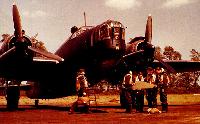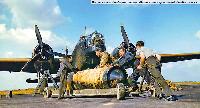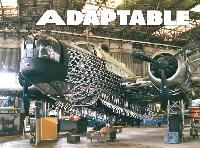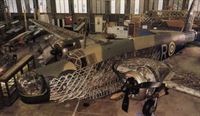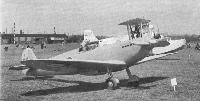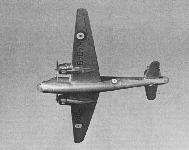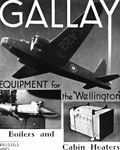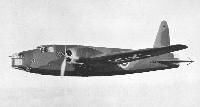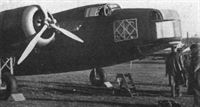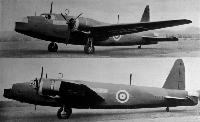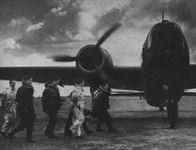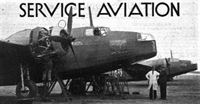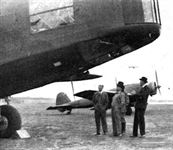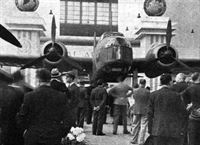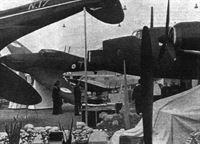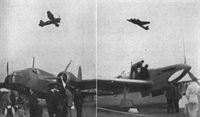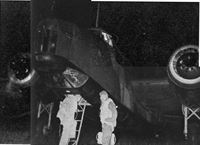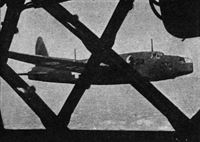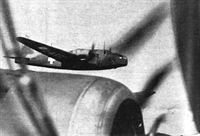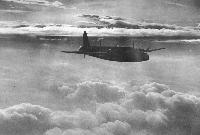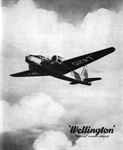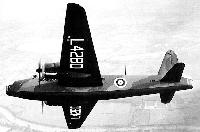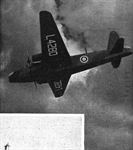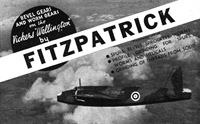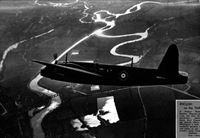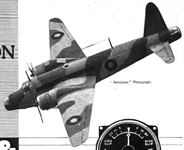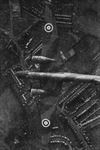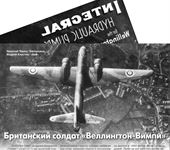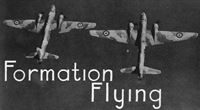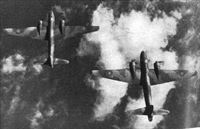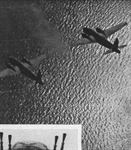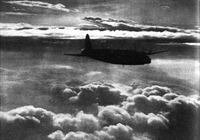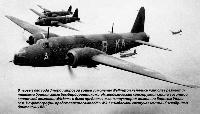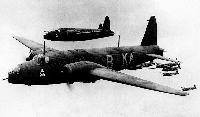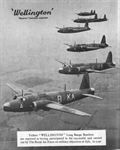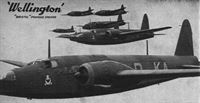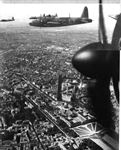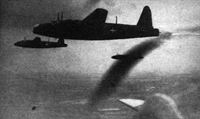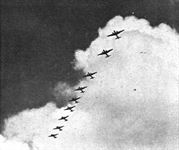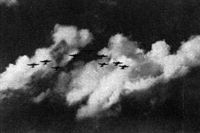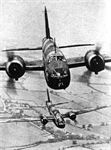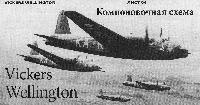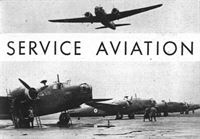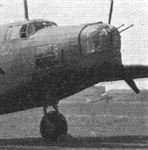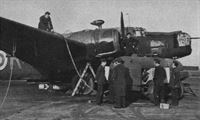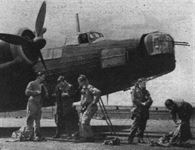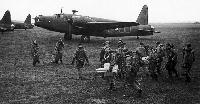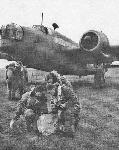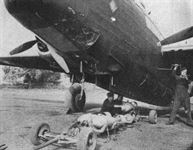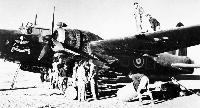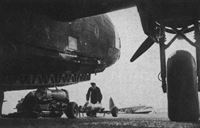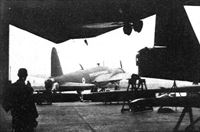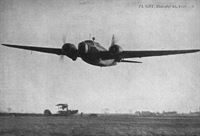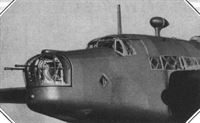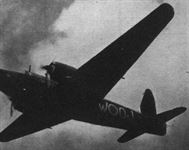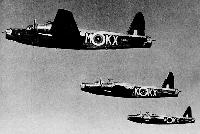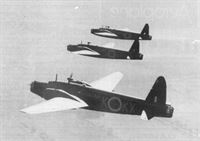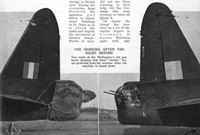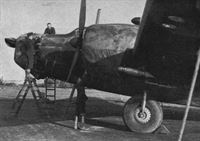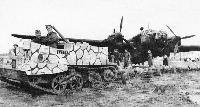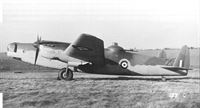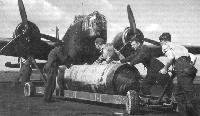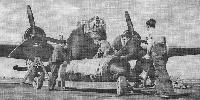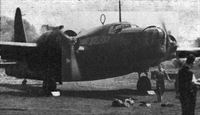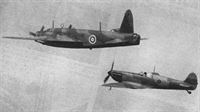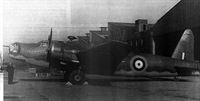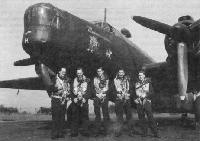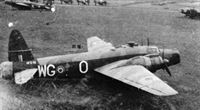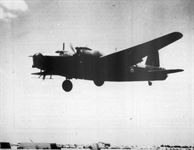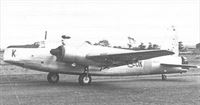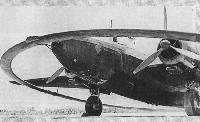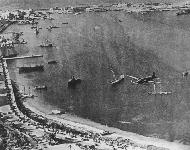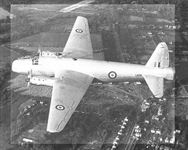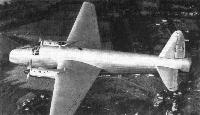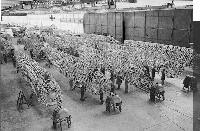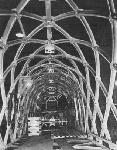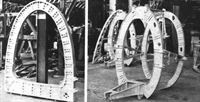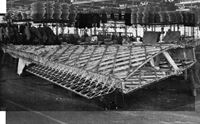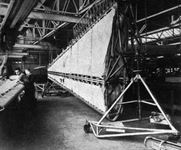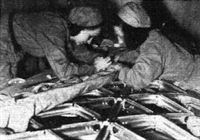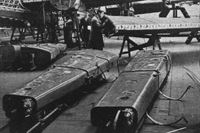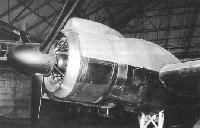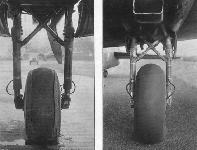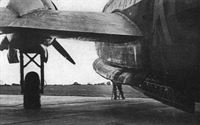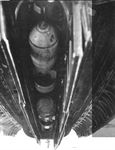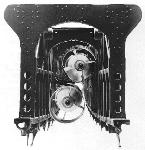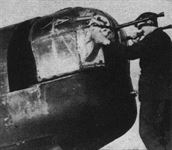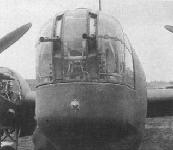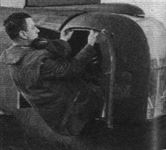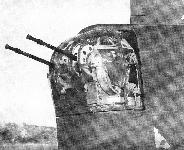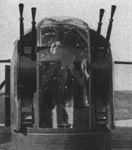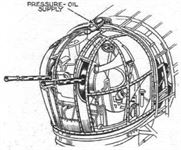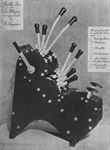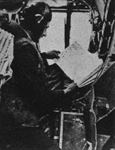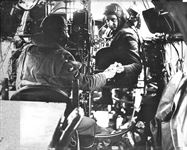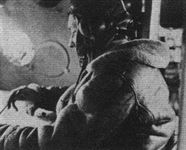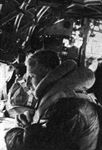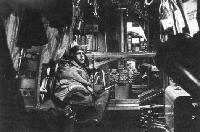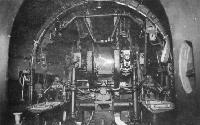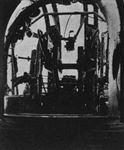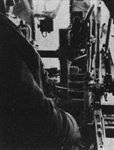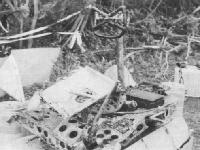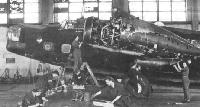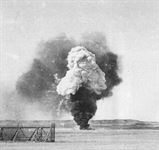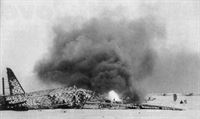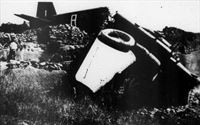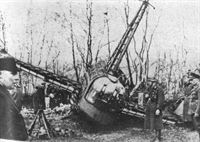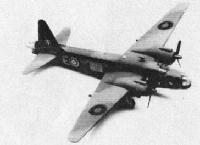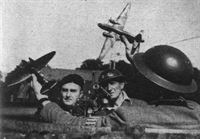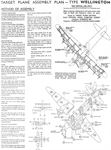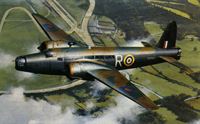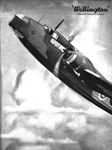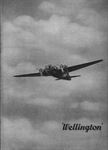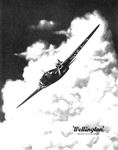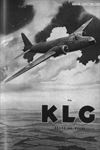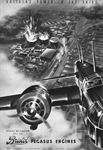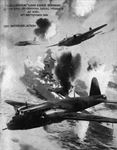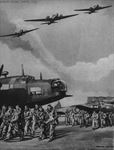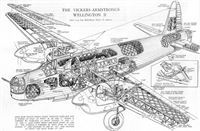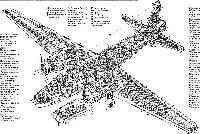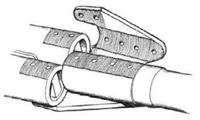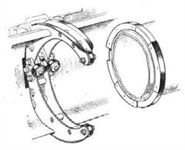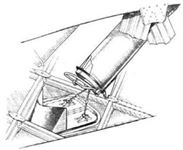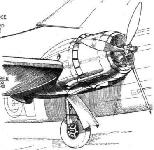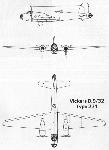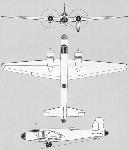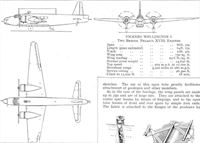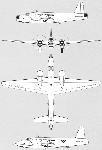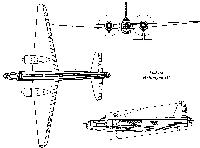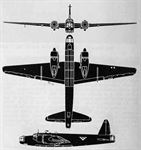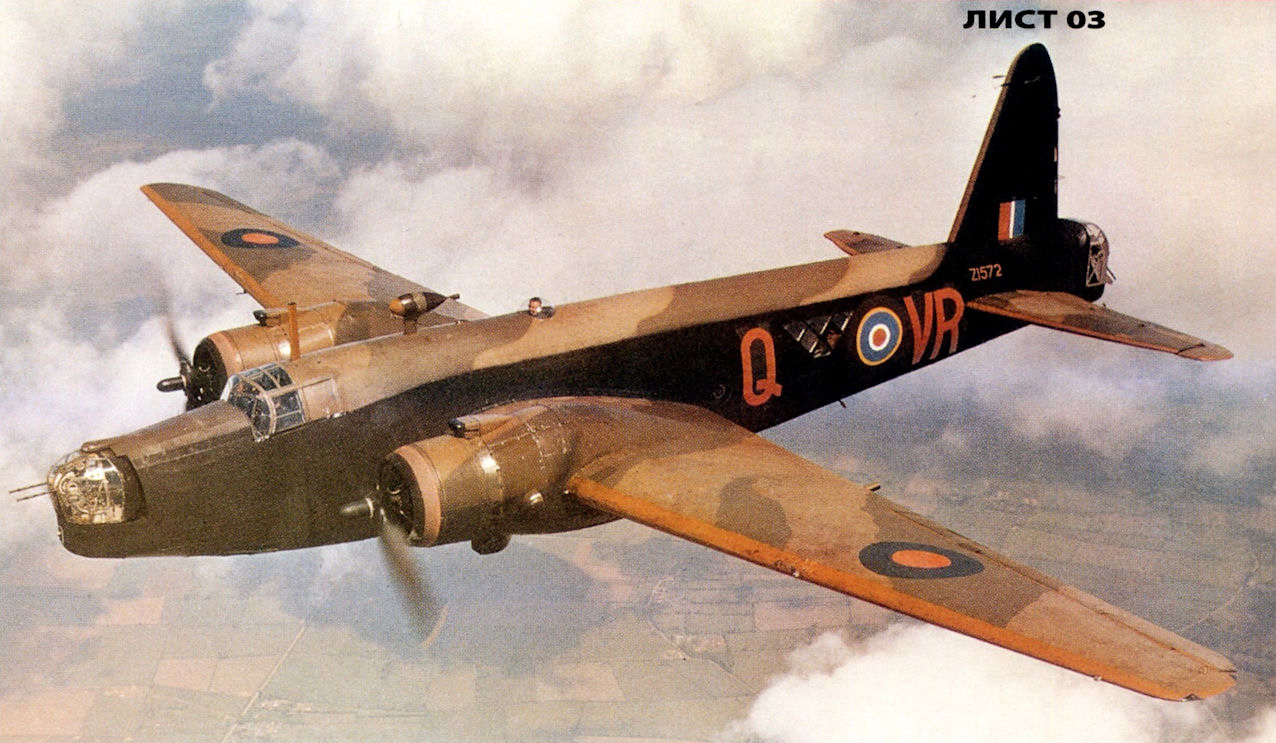
Описание
Страна : Великобритания
Год : 1936
Средний бомбардировщик с экипажем из шести человек
Варианты
- Vickers - Wellington / Type 271 - 1936 - Великобритания
- Vickers - Wellington Mk.V / Mk.VI - 1940 - Великобритания
- Vickers - Wellington GR - 1941 - Великобритания
- Vickers - Wellington C - 1943 - Великобритания
Wellington / Type 271
Средний бомбардировщик, цельнометаллический двухмоторный моноплан с убирающимся шасси с хвостовым колесом. Основное отличие конструкции - геодетический набор, обтянутый полотном. Экипаж 5 - 6 человек. Спроектирован в КБ фирмы "Виккерс авиэйшн" под руководством Б.Уоллиса и К.Пирсона. Опытный бомбардировщик "тип 271" ("Креси") впервые поднялся в небо 15 июня 1936 г. Серийное производство начато в декабре 1937 г. под названием "Веллингтон". Строился на заводах "Виккерс" в Вейбридже, Честере, Блэкпуле, Смитс-Лауне. Всего выпущено 11 461 экз. (самый массовый английский бомбардировщик). Состоял на вооружении в Великобритании с октября 1938 г., во Франции - с середины 1945 г. (как учебный). Выпускался в вариантах бомбардировщика, противолодочного патрульного и военно-транспортного самолета, тральщика магнитных мин.
Основные серийные модификации как бомбардировщика:
- "Веллингтон" I с моторами "Пегасус" XX или XVIII, вооружение 4x7,69, на варианте IA - 6x7,69, измененный бомбоотсек, усиленное шасси; IC - перемещено вооружение, изменено внутреннее оборудование;
- "Веллингтон" II с моторами "Мерлин" X, вооружение по типу IC;
- "Веллингтон" III с моторами "Геркулес" XI, вооружение 8x7,69;
- "Веллингтон" IV с моторами R-1830S3C4-G, вооружение 8x7,69;
- "Веллингтон" X, вариант модификации III с усиленным планером и моторами "Геркулес" VI или XVI.
Бомбовая нагрузка до 1815 кг.
"Веллингтоны" применялись с сентября 1939г. как дальние разведчики, дневные и ночные бомбардировщики; с начала 1940г. - только ночью. В 1942 - 1943 гг. - основной самолет Бомбардировочного командования Королевских ВВС. С сентября 1940 г. "Веллингтон" начал воевать в Северной Африке, весной 1941 г. участвовал в отражении нападения немцев на Грецию, с апреля 1942 г. использовался на Дальнем Востоке (на индобирманском фронте). Применялся британскими ВВС до конца войны.
Снят с производства в октябре 1945 г. Снят с вооружения во Франции в 1947 г., в Великобритании - в марте 1953 г.
"Веллингтон" B.III||
Размах:||26,2 м
Длина:||18,53 м
Моторы, количество х мощность:||2x1375 л.с.
Взлетная масса, максимальная:||13400 кг
Максимальная скорость:||408 км/ч
Практический потолок:||5800 м
Дальность:||3500 км
Описание:
- Wellington / Type 271
- Vickers Type 271 Wellington
- Flight, July 1939
GEODETICS on the GRAND SCALE - Flight, November 1939
Britain's Military Aircraft
Фотографии
-
Авиация и Время 2014-03 / Н.Терец, А.Хаустов - Британский солдат "Веллингтон-Вимпи"
Регистрационный номер: L4261 Wellington Mk. I из 9-й эскадрильи Королевских ВВС Великобритании. Стрэдишелл, август 1939 г.
-
Мировая Авиация 119
Регистрационный номер: L7779 3 сентября 1939 года 37-я эскадрилья совершила первый налет на Германию во Второй мировой войне. В декабре в одном из налетов она потеряла пять из шести самолетов, что заставило Бомбардировочное командование перейти к ночным действиям. Этот самолет версии Mark IA поступил на вооружение в апреле 1940 года, когда эскадрилья базировалась в Фелтуелле, Норфолк.
-
Мировая Авиация 249
Регистрационный номер: R1492 Данный Wellington Mk 1C принадлежал 99-й эскадрилье (Madras Presidency), дислоцированной в Милденхолле. Первый ее боевой вылет состоялся 8-9 сентября 1939 года - два Wellington разбросали листовки нал Ганновером.
-
Aviation Historian 39 / M.Napier - Taking the war to the enemy
Регистрационный номер: Z1392 Built by Vickers at Hawarden, Wellington IV Z1392, bearing the unit code “UV” and the individual letter “G”, is depicted here in the colours it wore while serving with No 460 Sqn RAAF (motto "Strike and Return”) in the spring of 1942.
-
Air Pictorial 1956-05 / ??? - RAF experimental aircrafts
Intended for anti-submarine operation, this Wellington Mk. VII was the Mk.II prototype with a dorsal 40-mm. Vickers "S" gun. Later, the single fin and rudder was replaced by twin units.
-
Мировая Авиация 241
Регистрационный номер: HZ850 Wellington Mk X поступили на вооружение 99-й и 215-й эскадрилий британских ВВС, переброшенных в Индию для налетов на японские базы в Бирме в течение 1943-1944 годов. На рисунке изображен HZ950 из 99-й эскадрильи, несущий характерные двухтоновые синие/голубые опознавательные знаки ТВД (датируется 1944 годом).
-
Air Enthusiast 2006-11 / F.Prins - Adaptable Stalwart /World war two/ (1)
Wellington of 9 Squadron, complete with the 'dust-bin' turret
-
Авиация и Время 2014-03 / Н.Терец, А.Хаустов - Британский солдат "Веллингтон-Вимпи"
Регистрационный номер: LP805 [3] Wellington T Mk. X из состава мальтийского связного авиазвена. Самолет был разбит при взлете с аэродрома Лука 31 августа 1946 г. Самолет имел нестандартные остекление фюзеляжа и дверь по правому борту
-
Мировая Авиация 141
Регистрационный номер: Z1572 [3] Изображен Wellington Mk III из 419-й эскадрильи "Moose" канадских ВВС, верхние поверхности которого окрашены в темно-землистый/темно-зеленый камуфляж, а борта и нижние поверхности - в темный "ночной" камуфляж.
-
Air Enthusiast 1996-11 / K.Ellis - The other 'Whimpey'
Регистрационный номер: MF628 [11] Last of the many... MF628 in Bomber Command colours in the static at Abingdon for the Review of the RAF, June 1968.
-
Aeroplane Monthly 2000-04 / 2000 Airshows & Museums Guide
Регистрационный номер: MF628 [11] The Royal Air Force Museum’s Vickers Wellington X, MF628, at a Hatfield display in the late 1950s, before its nose turret was fitted.
-
Air Enthusiast 1996-11 / K.Ellis - The other 'Whimpey'
Регистрационный номер: MF628 [11] View of MF628 on a rare sortie outside its storage hangar at Biggin Hill, probably in 1964.
-
Air Enthusiast 1996-11 / K.Ellis - The other 'Whimpey'
Регистрационный номер: MF628 [11] -
Мировая Авиация 117
Экипаж Wellington Mk III уточняет задание перед боевым вылетом. На фюзеляже за кабиной виден обтекатель рамочной антенны радиокомпаса.
-
Авиация и Космонавтика 2018-04 / А.Широкорад - Разрушение Европы (1)
Подвеска под бомбардировщик «Веллингтон» двухтонной бомбы «Куки»
-
Air Enthusiast 2007-01 / F.Prins - Adaptable Stalwart /World war two/ (2)
Регистрационный номер: MF628 [11] T.10 MF628 displayed at the RAF Museum, Hendon.
-
Моделист-Конструктор Бомбардировщики Второй мировой войны
Регистрационный номер: MF628 [11] Ночной бомбардировщик "Веллингтон" (Англия) стоит в Музее Королевских ВВС в Хендоне
-
Air Enthusiast 2006-11 / F.Prins - Adaptable Stalwart /World war two/ (1)
Регистрационный номер: N2980 [16] Recovered from the bottom of Loch Ness in September 1985, Wellington IA N2980 is now restored to its geodetic glory and on display at the Brooklands Museum.
-
Aeroplane Monthly 1996-07 / 1996 UK Aircraft Collections and Museums Guide (1)
Регистрационный номер: N2980 [16] Wellington 1A N2980 R-Robert is a big crowd-puller at the Brooklands Museum. It is currently undergoing restoration to static display condition under the watchful eye of visitors.
-
Aeroplane Monthly 1996-12 / M.Oakey - Vintage news
Регистрационный номер: N2980 [16] Another interim winner in the Scania awards scheme is the Brooklands Museum’s Vickers Wellington, N2980 R-Robert. Like the RNHF Swordfish, it wins £500 and a place in next February’s final. In rewarding the museum for its efforts, the Scania judges cited the achievement of the aircraft’s rescuers - who salvaged the Wimpy from the peaty depths of Loch Ness in 1985 - and the technical complexity of the static restoration. Seen here with its unorthodox geodetic structure complete and partly covered, N2980 was also one of the leading contenders in Aeroplane’s own Preservation Project of the Year Award last year, and is attracting votes again this time round.
-
Aeroplane Monthly 1999-05 / 1999 UK Airshows & Museums Guide
Регистрационный номер: N2980 [16] “Loch Ness” Wellington N2980 is a star exhibit.
-
Aeroplane Monthly 1986-07 / A.Lumsden, T.Heffernan - Probe Probare (26)
Регистрационный номер: K4049 [20] Прототип Vickers B.9/32 (K4049) совершил первый полет в Бруклэндс 15 июня 1936 года. После того, как он разбился в апреле 1937 года, в конструкцию самолета пришлось внести множество изменений.
The B.9/32 Wellington prototype, K4049, before delivery to Martlesham Heath.
OVER-RIDE: The new Vickers "geodetic" medium bomber with its twin Pegasus engines receiving over-ride boost, sails up like a fighter. This machine represents a new class of bomber, the development of which is receiving close attention in this country. -
Aeroplane Monthly 1986-07 / A.Lumsden, T.Heffernan - Probe Probare (26)
Регистрационный номер: K4049 [20] The Wellington prototype shows off its clean lines in the air. The nose was still fabric-faired when this photograph was taken.
THE VICKERS WELLINGTON, fitted with “Bristol” Pegasus engines, is a twin-engined, mid-wing monoplane of Vickers "geodetic" construction; with cantilever wings, retractable undercarriages, patent ailerons, split flaps and controllable-pitch airscrews. Designed for fast long-range bombing or service transport, the normal crew numbers four, including two pilots. No performance figures are available for publication. In production for the Air Ministry by Vickers (Aviation) Ltd. -
Flight 1936-06 / Flight
Регистрационный номер: K4049 [20] The twin-engined, so far un-named machine, have Bristol Pegasus engines and is of "geodetic" construction.
-
Aeroplane Monthly 1986-07 / A.Lumsden, T.Heffernan - Probe Probare (26)
Регистрационный номер: K4049 [20] The B.9/32 Wellington prototype, K4049, before delivery to Martlesham Heath. The aircraft is seen flying at the RAF Display in June 1936, only days after its first flight, made from Brooklands on June 15, and is numbered 7 for exhibition in the Hendon new-types park.
-
Flight 1936-11 / Flight
Регистрационный номер: K4049 [20] A medium bomber of impressive appearance and performance, the first Vickers twin-engined "geodetic" monoplane has been adopted by the R.A.F. under the name Wellington.
-
Air Enthusiast 2006-11 / F.Prins - Adaptable Stalwart /World war two/ (1)
Регистрационный номер: K4049 [20] The Vickers B9/32 K4049 at Brooklands, June 1936, wearing the Hendon 'New Types Park' number' T in front of the fuselage roundel.
-
Aeroplane Monthly 1986-07 / A.Lumsden, T.Heffernan - Probe Probare (26)
Регистрационный номер: K4049 [20] The Wellington prototype photographed at Brooklands on June 30, 1936, at a pre-Pageant display of Vickers aircraft.
-
Авиация и Время 2014-03 / Н.Терец, А.Хаустов - Британский солдат "Веллингтон-Вимпи"
Регистрационный номер: K4049 [20] Первый прототип «Веллингтона» существенно отличался от серийного бомбардировщика
-
Aeroplane Monthly 1986-07 / A.Lumsden, T.Heffernan - Probe Probare (26)
Регистрационный номер: K4049 [20] The Wellington prototype photographed at Brooklands on June 30, 1936, at a pre-Pageant display of Vickers aircraft. Note the uncompleted dorsal turret and the fairings over the nose and tail turret positions.
-
Aeroplane Monthly 1974-09 / ??? - Hendon Pageantry 1920-37
Регистрационный номер: K4049 [20] The shape of wings to come. Monoplanes fill the new types park at the 1936 pageant.
Другие самолёты на фотографии: Armstrong Whitworth Whitley / A.W.38 - Великобритания - 1936Fairey Battle - Великобритания - 1936Supermarine Spitfire - Великобритания - 1936Vickers Venom - Великобритания - 1936Westland Lysander - Великобритания - 1936
-
Jane's All the World Aircraft 1980 / Encyclopedia of Aviation - Aircraft A-Z - v5
Регистрационный номер: K4049 [20] K5054 был впервые показан 300 приглашенным гостям 18 июня 1936 года на демонстрации самолетов фирмы "Vickers" в Истли, На снимке: K4049 - прототип бомбардировщика В.9/32 (позднее служившего под именем Wellington); K7556 - предсерийный бомбардировщик Wellesley и K5780 - девятая серийная амфибия Walrus. В 1938 году "Supermarine Aviation Works (Vickers) Ltd" и ее головная компания "Vickers (Aviation) Ltd of Weybridge" объединились в фирму "Vickers-Armstrong Limited".
Supermarine Spitfire prototype on view to the public in 1936 alongside a Walrus, the prototype Wellesley and prototype Wellington.Другие самолёты на фотографии: Supermarine Spitfire - Великобритания - 1936Supermarine Walrus/Seagull V - Великобритания - 1933Vickers Wellesley - Великобритания - 1935
-
Aeroplane Monthly 1976-03 / C.Andrews, E.Morgan - The First of the Many
Регистрационный номер: K4049 [20] Another view of K5054 at the pre-Pageant show at Brooklands on June 30, 1936. Behind it are Supermarine Walrus I K5780, Vickers Wellesley prototype K7556 and Vickers B.9/32 prototype K4049, later to become the Wellington.
Другие самолёты на фотографии: Supermarine Spitfire - Великобритания - 1936Supermarine Walrus/Seagull V - Великобритания - 1933
-
Air Enthusiast 2006-11 / F.Prins - Adaptable Stalwart /World war two/ (1)
Регистрационный номер: K4049 [20] The Vickers B9/32 with glazed areas in the nose and tail.
-
Aeroplane Monthly 1986-08 / E.Morgan, E.Shacklady - The basketweave bomber (1)
Регистрационный номер: K4049 [20] Perhaps the most famous B.9/32 photograph of all, taken as the prototype was pushed across the bridge spanning the River Wey at Brooklands.
-
Flight 1937-11 / Flight
Регистрационный номер: K4049 [20] The Pegasus-powered Vickers Wellington I prototype. Production versions of this extremely efficient medium bomber are likely to differ in certain respects.
-
Aeroplane Monthly 1986-07 / A.Lumsden, T.Heffernan - Probe Probare (26)
Регистрационный номер: K4049 [20] The B.9/32 running-up its engines beside the Vickers factory at Brooklands.
-
Aeroplane Monthly 1986-07 / A.Lumsden, T.Heffernan - Probe Probare (26)
Регистрационный номер: K4049 [20] The Wellington flying early in 1937. The original stubby fin and rudder were completely redesigned for production aircraft. Note that the nose glazing has been fitted. It will be noted in the view that crankcase cowlings of a type which was popular in the U.S.A. some years ago have been fitted experimentally.
-
Aeroplane Monthly 1986-08 / E.Morgan, E.Shacklady - The basketweave bomber (1)
Регистрационный номер: K4049 [20] Первый прототип «Веллингтона» в полете
K4049 in flight. The aircraft was destroyed on April 19, 1937 at Waldringfield, not far from Martlesham Heath.
-
Flight 1938-01 / Flight
Регистрационный номер: L4212 [6] GEODETIC TWIN: The production-type Vickers Wellington I (two Pegasus XVII) built, like the Wellesley, on the geodetic principle. Part of the construction can be glimpsed through the Perspex of the bomb-aimer's window.
-
Flight 1938-01 / Flight
GEODETIC BOMBER: The production-type Vickers Wellington I medium bomber awaiting tests at Weybridge.
-
Flight 1938-12 / Flight
One of the neatest large undercarriages yet seen that of the Vickers Wellington twin-engined bomber.
-
Flight 1939-07 / Flight Advertisements
Регистрационный номер: L4212 [6] -
Air Enthusiast 2006-11 / F.Prins - Adaptable Stalwart /World war two/ (1)
Регистрационный номер: L4212 [6] IN SERVICE SOON: A new view of the Pegasus-engined Vickers Wellington I medium bomber, which will before long be standard equipment in the R.A.F. There is a Nash and Thompson multi-gun turret in the nose and stern, and a third gun position amidships.
View of the prototype Wellington Mark I, L4212, first flown on December 23, 1937, from Brooklands with “Mutt" Summers in command. It was later converted to DWI status. -
Aeroplane Monthly 1986-08 / E.Morgan, E.Shacklady - The basketweave bomber (1)
Регистрационный номер: L4212 [6] View of the prototype Wellington Mark I, L4212, first flown on December 23, 1937, from Brooklands with “Mutt" Summers in command.
The much-discussed Vickers Wellington bomber with Pegasus engines is the second machine of geodetic construction to be adopted. The Rolls-Royce Merlin and Bristol two-row Hercules are alternative power units. Nose and tail turrets are installed. -
Flight 1938-01 / Flight
DUCAL DIGNITY: The first production-type Vickers Wellington I <...> bomber built on the geodetic principle and powered with two Bristol Pegasus XVII radials with two-speed blowers. The transparency of the <...>nd tail turret roofs in this view gives a false impression of marring the fine lines of the fuselage which, incidentally, <...> revised since the prototype appeared.
-
Aeroplane Monthly 1985-02 / L.Coombs - The expanding years 1936-1939 (4)
Регистрационный номер: L4212 [6] The prototype Wellington Mk I bomber, L4212, taking off from Brooklands in December 1937. This aircraft was a complete redesign of the B.9/32, originally called the Crecy but changed to Wellington in September 1936.
The Vickers Wellington is built on the geodetic principle of construction, which confers high load carrying capacity and long range. -
Flight 1938-02 / Flight
Регистрационный номер: L4212 [6] The protoype Wellington, Mk 1 L4212, was first flown on December 23, 1937 from Brooklands and is seen landing there in January 1938.
-
Flight 1938-02 / Flight
“This desirable Tudor residence” is suggested by the geodetic window-panes of the Vickers Wellington I medium bomber (two Bristol Pegasus with two-speed superchargers), but the performance is anything but medieval. This, the production job - photographed by Flight Brooklands last week - has been very considerably cleaned-up as compared with the prototype which, it may be remembered, had an oddly insect-like bulge at the tip of the tail. The unfamiliar fittings within the collector rings are Vickers crankcase cowlings.
-
Jane's All the World Aircraft 1938 / 03 - All the world's aeroplanes
Регистрационный номер: L4213 [2] The Vickers "Wellington" Long-range Bomber Monoplane (two Bristol "Pegasus" engines).
-
Flight 1939-02 / Flight
Регистрационный номер: L4213 [2] A Vickers Wellington long-range bomber of the type adopted by the R.N.Z.A.F.
-
Flight 1939-08 / Flight
FIRST FROM CHESTER: This perfectly normal Wellington is of special interest because it was assembled and delivered to the Service only eight months after work had been started on the building of the new Vickers-Armstrong works at Broughton, Chester.
-
Flight 1940-08 / Flight
With engines warmed up he crew - five in the case of a Wellington or Whitley - get aboard ready for the take-off.
-
Flight 1938-10 / Flight
VICKERS WELLINGTON long-range bombers (Pegasus) awaiting test at Brooklands. The crankcase cowlings are interesting.
-
Flight 1938-09 / Flight
The Air Minister is seen under the imposing nose of a Wellington, with a Wellesley in the background. On the left is Sir Robert McLean, chairman of Vickers Aviation Ltd.
Другие самолёты на фотографии: Vickers Wellesley - Великобритания - 1935
-
Flight 1939-07 / Flight
The Wellington I, on the Air Ministry stand, is the largest aircraft in the Show
-
Flight 1939-07 / Flight
A British quartet impressively grouped: the Speed Spitfire, Hurricane, Oxford and Wellington.
Другие самолёты на фотографии: Airspeed Oxford / AS.10 - Великобритания - 1937Hawker Hurricane - Великобритания - 1935Supermarine Highspeed Spifire - Великобритания - 1938
-
Aeroplane Monthly 1986-09 / E.Morgan, E.Shacklady - The basketweave bomber (2)
Wellington Is of 149 Sqn. Based at Mildenhall; the squadron first equipped with Wellingtons in January 1939 and began night bombing in May 1940.
-
Flight 1939-08 / Flight
As the sun sets the night-bombing Wellingtons are dragged from their hangars.
-
Flight 1939-11 / Flight
The Vickers Wellington I bomber does 265 m.p.h. with two Bristol Pegasus XVIII engines.
-
Авиация и Время 2014-03 / Н.Терец, А.Хаустов - Британский солдат "Веллингтон-Вимпи"
Первый серийный «Веллингтон» Mk.I на мосту через реку Вей по дороге на аэродром Бруклендс
-
Flight 1938-05 / Flight
All in the picture: Westland Lysander over Vickers Wellington, and Bristol Blenheim over Fairey P.4/34.
Другие самолёты на фотографии: Bristol Blenheim - Великобритания - 1936Fairey Fulmar / P.4/34 - Великобритания - 1937Westland Lysander - Великобритания - 1936
-
Flight 1940-08 / Flight
Boarding an Eastland Wellington at Stradishall prior to a bombing raid over “blacked out” Westland.
Back at the 'drome legs can be stretched after hours of cramped sitting, parachute harness and Mae Wests removed. Later a glass of beer and a cigarette can be enjoyed as the crew recount their experiences to an Intelligence Officer. -
Flight 1939-07 / Flight
This aerial photograph gives a good idea of the Wellington's external appearance. It also shows the excellent provision for admitting daylight.
-
Flight 1939-08 / Flight
A "friendly" Wellington as seen through the geodesics of a consort. The white cross was the distinguishing mark.
-
Flight 1939-08 / Flight
Регистрационный номер: L4370 Another intimate glimpse of a “friendly” Wellington over the nacelle.
-
Aviation Historian 39 / M.Napier - Taking the war to the enemy
Heads up! A Wellington I of No 11 OTU performs a lively low-level pass over the grass at the unit’s base at Bassingbourn in Cambridgeshire. One of the RAF’s newer bases, Bassingbourn opened in March 1938 and was the most easterly of Bomber Command’s OTUs, and was thus subject to frequent attacks from Luftwaffe intruders.
-
Aeroplane Monthly 1987-01 / E.Morgan, E.Shacklady - The basketweave bomber (6)
A Wellington 1A takes off from RAF Bassingbourn in November 1940.
-
Flight 1939-07 / Flight
Manoeuvrability is an outstanding quality of the Wellington.
-
Flight 1940-03 / Flight
"...Likewise the amazing production of the Wellington..."
-
Flight 1939-03 / Flight Advertisements
Регистрационный номер: L4215 [3] -
Flight 1939-07 / Flight Advertisements
Регистрационный номер: L4215 [3] -
Flight 1939-10 / Flight
Регистрационный номер: L4369 [2] "Some of the longer reconnaissance flights - of 1,000 miles or so - have been carried out at night under weather conditions of great difficulty." A Vickers Wellington above the clouds.
-
Мировая Авиация 141
Регистрационный номер: L4280 [3] Первыми серийными Wellington стали 180 самолетов модификации Mk I (заказ размещен в августе 1936 года). Большинство оснащались двигателями Bristol Pegasus XVIII. Первые машины поступили в 99-ю эскадрилью в октябре 1938 года. Изображенный L4280 был передан 148-й эскадрилье в марте 1939 года. Среди первых самолетов Wellington были шесть машин, заказанных новозеландскими ВВС, но с началом войны все поступили в британские ВВС.
-
Flight 1939-03 / Flight
Регистрационный номер: L4280 [3] GEODETICS ON THE GRAND SCALE: Flt. Lt. J. Summers, chief test pilot to the Vickers-Armstrong group, shows off some of the finer points of the Wellington long-range bomber near Weybridge. Wellingtons are coming through at a highly creditable rate and are taking up the brightly burning torch of geodesy from the Wellesley. The engines are Bristol Pegasus.
-
Flight 1939-12 / Flight Advertisements
Регистрационный номер: L4280 [3] -
Flight 1939-03 / Flight
ENGLISH as the THAMES. A Vickers Wellington bomber - Pegasus-powered - on test near its home aerodrome; those who know their Thames will see exactly where. The Wellington is built on the exclusive geodetic system and ranks as one of the world’s most formidable bombers.
-
Flight 1939-08 / Flight
A "friendly" Wellington slips low over East Anglia. These non-combatant machines were included for their "nuisance value."
-
Flight 1939-05 / Flight
Vickers-Wallis geodetic construction gives the Vickers Wellington great weight-lifting powers. The engines may be of the Bristol Pegasus, Bristol Hercules, or Rolls-Royce Merlin type.
-
Flight 1939-05 / Flight
PROTECTIVE COLORATION: A convincing plan view of a Vickers Wellington (two Bristol Pegasus) adopting the mantle of suburban respectability.
-
Flight 1939-11 / Flight Advertisements
A Vickers Wellington show in a striking fashion the effectiveness of its camouflage markings.
-
Flight 1939-11 / Flight
DISTINGUISHED SERVICE has already been done by Vickers Wellington I bombers, two of which aircraft are seen over the sea in the Flight photograph. The Wellington does 265 m.p.h. and is the biggest of the R.A.F.’s landplane bombers.
-
Flight 1940-08 / Flight
Night bombers usually fly alone, the timetable arranging for any concentration which may be thought necessary, but sometimes ways are together for a while and company is pleasant over a long sea trip.
-
Flight 1940-01 / Flight
OVER THE NORTH SEA: One of the most popular and successful bombers ever to go into service is the Vickers Wellington which has already done magnificent work in the war. Two of these machines, which carry a very heavy bomb load and are armed with six machine guns, are seen nosing out over the North Sea.
-
Flight 1939-10 / Flight
Регистрационный номер: L4369 [2] A DANGEROUS VIEW for the pilot of an “E.A.” to have of the Vickers Wellington bomber is that shown here. The tail gunner can easily bring the stern armament to bear.
-
Aeroplane Monthly 1996-05
Flying to the Moon
-
Flight 1939-10 / Flight
HOMING: After a long night’s flying a Vickers Wellington bomber approaches its aerodrome as the early sun tinges the clouds below. Soon the pilot will switch the blowers of his two Pegasus engines into low gear and descend.
-
Aeroplane Monthly 1994-03 / J.Maynard - Pickard, hero of Amiens (1)
Bomber Command’s standard heavy aircraft at the outbreak of war were the Hampden, in the background, and the Wellington, both flown by Pickard during his career.
Другие самолёты на фотографии: Handley Page Hampden / H.P.52 - Великобритания - 1936
-
Мировая Авиация 249
В первые два года Второй мировой войны самолеты Wellington являлись наиболее результативными британскими бомбардировщиками. Их геодезическая конструкция стала визитной карточкой компании «Vickers» и была предложена конструктором компании Барнсом Уоллисом. На фотографии представлены самолеты Mk 1 с эмблемой «летучая мышь» IX эскадрильи британских ВВС.
-
Мировая Авиация 117
Боевой порядок Wellington Mk I из 9-й эскадрильи британских ВВС - снимок сделан на учении в 1939 году. 9-я эскадрилья воевала на Wellington до августа 1942 года, когда ее перевооружили на Lancaster Mk I.
-
Flight 1940-04 / Flight Advertisements
Vickers "WELLINGTON" Long Range Bombers are reported as having participated in the successful raid carried out by The Royal Air Force on military objectives at Sylt, 20.3.40,
-
Flight 1940-03 / Flight
One of the most successful large bombers ever built is the powerfully armed geodetic-built Vickers Wellington, which, on many occasions, has distinguished itself on active service.
-
Flight 1939-07 / Flight
Регистрационный номер: L4288 TAKING-UP FORMATION: Especially during the air exercises last week-end, quite large formations of Wellingtons have been in evidence. Even a quartet of these impressive aeroplanes makes an inspiring spectacle
Wellington I L4288 leads three other 9 Sqn Wellingtons over the English countryside for the benefit of Charles E. Brown’s camera in 1939. L4288 crashed near Honington on October 30 of that year after a mid-air collision. Note the single front gun with its cover fitted. -
Flight 1939-07 / Flight
«Веллингтоны» Mk. I из 149-й эскадрильи над Парижем в ходе визита в День взятия Бастилии. 14 июля 1939 г.
"SECRETS TRAVEL FAST IN PARIS" - Napoleon. Wellingtons over Paris during the recent "flag-showing" visit of British bomber squadrons to France. Those acquainted with the French capital will recognise the Invalides in this impressive photograph. The picture was secured from another Wellington in the formation, and the “dish-pan” cowling of one of the Pegasus XVIII engines can be seen. -
Flight 1940-05 / Flight
Big bombers: Armstrong Whitworth Whitleys and Vickers-Armstrongs Wellingtons (shown) are two of the key types operating with the Bomber Command. Both machines have put up a magnificent showing when attacked by enemy fighters, their armament being five machine guns each. These are mounted in power-driven turrets.
-
Flight 1939-07 / Flight
“Escadrille de 9 avions Vickers-Wellington - vol en echelon refuse vers la droite.”
-
Aeroplane Monthly 1987-04 / T.Dudgeon - A dirty night
Retribution in transit. A Wellington on its way to Germany in 1941.
-
Авиация и Время 2014-03 / Н.Терец, А.Хаустов - Британский солдат "Веллингтон-Вимпи"
Экипажи 9-й эскадрильи отрабатывают на своих «единичках» групповую слетанность. Лето 1939 г.
-
Мировая Авиация 241
10 июля 1939 года данные Wellington Mk I из 9-й (бомбардировочной) эскадрильи (АБ Страдисхолл) вместе с машинами из еще четырех эскадрилий были переброшены во Францию. На тот момент Wellington был лучшим самолетом британского Бомбардировочного командования.
-
Aeroplane Monthly 1986-09 / R.Cooling - Dutch courage
Регистрационный номер: T2468 The brand new Vickers Wellington was a Mk IC, T2468 Y-Yorker. She was a beauty!
-
Aeroplane Monthly 1986-09 / E.Morgan, E.Shacklady - The basketweave bomber (2)
Part of a batch of Wellingtons fresh from the production line in early 1940, with armament still to be installed.
-
Flight 1940-03 / Flight
AWAITING THEIR TURN: Vickers Wellington bombers just "off the line," with a machine of the same batch taking off for its routine test.
-
Flight 1940-03 / Flight
Great Britain has developed the power-driven gun turret to a very high pitch of perfection. Here is the nose installation in the Vickers Wellington;
-
Flight 1940-12 / Flight
THE RIGHT SPIRIT: Refuelling a Wellington 1A ready for the night's raid.
-
Flight 1940-10 / Flight
GETTING THINGS BUTTONED UP: An air crew putting on their Irvin Harnisuits, which incorporate both parachute harness and flotation jacket. The machine is a Wellington Ia, which has a twin gun turret in the nose.
-
Мировая Авиация 15
25-26 августа 1940г.: в эту ночь 43 самолета Бомбардировочного командования выполнили первый налет британской авиации на Берлин. Среди них были бомбардировщики Vickers Wellington из 143-й эскадрильи.
-
Мировая Авиация 119
Экипажи Vickers Wellington 149-й эскадрильи, базирующейся в Милденхолле, графство Суффолк, садятся в свои самолеты для ночного налета на Германию. Эта эскадрилья сыграла заметную роль в первых подобных рейдах.
-
Мировая Авиация 241
Экипаж одного из ранних Wellington готовится к очередному вылету. Бортстрелки носили тяжелые утепленные штаны и куртки из овчины. Позже многие ранние Wellington Mk I были сняты британцами с фронта и переоборудованы в транспортные самолеты. В частности, такие 18-местные машины использовались на Ближнем и Среднем Востоке.
-
Aviation Historian 39 / M.Napier - Taking the war to the enemy
A rare photograph of a Wellington IC of “E” Flight, No 21 Operational Training Unit (OTU), based at Moreton-in-Marsh in Gloucestershire. After commencing flying operations in the spring of 1941, No 21 OTU was tasked specifically with training crews for the Middle East. Note No 21 OTU’s “SJ” code letters on the fuselage.
-
Авиация и Время 2014-03 / Н.Терец, А.Хаустов - Британский солдат "Веллингтон-Вимпи"
Ремонт "Веллингтона" Mk.IC в ангаре 214-й эскадрильи. Стрэдишелл, лето 1941г.
-
Авиация и Время 2014-03 / Н.Терец, А.Хаустов - Британский солдат "Веллингтон-Вимпи"
Подвеска бомб под «Веллингтон» Mk. I
-
Flight 1940-09 / Flight
LOADING UP: Bombing up a Wellington for its nightly trip to the Continent. The optical flat panel for the bomb aimer is clearly seen under the nose with the downward recognition light immediately behind it.
-
Мировая Авиация 85
Основу британской бомбардировочной авиации в районе Западной пустыни составляли Vickers Wellington. На снимке: Mk 1С из 37-й эскадрильи, одной из шести вооруженных Wellington эскадрилий, дислоцировавшихся в регионе. Эти самолеты внесли большой вклад в нарушение коммуникаций противника, уничтожение баз, складов и конвоев.
-
Flight 1940-08 / Flight
Ruhral Transport: A Wellington being prepared for the usual night trip to Germany. Note the new shape of the camouflage painting to defeat the searchlights.
-
Flight 1940-10 / Flight
INCIPIENT RETRIBUTION: A Vickers Wellington in the process of being "bombed up" prior to a night raid on Germany.
-
Flight 1939-12 / Flight
Yet one more Wellington is taken from the erecting shops to the aerodrome for flight tests.
-
Мировая Авиация 117
Самым эффективным британским бомбардировщиком начального периода войны являлся Vickers Wellington. В сравнении с Whitley он имел более высокую скорость, a Hampden он превосходил по массе бомбовой нагрузки. Из строевых частей Wellington вытеснили лишь новые четырехмоторные бомбардировщики.
-
Мировая Авиация 141
Служба самолета в Бомбардировочном командовании в метрополии наиболее известна и "перекрыла" вклад Wellington в действиях на Среднем Востоке. Изображенный Mk 1C (из 70-й или 148-й эскадрильи) готовится на расположенном в пустыне аэродроме к очередному вылету, 1942 год. Обратите внимание - с самолета снято все оборонительное вооружение, это сделано для экономии массы и ввиду отсутствия угрозы со стороны истребителей противника в ходе ночных рейдов над пустыней.
-
Авиация и Время 2014-03 / Н.Терец, А.Хаустов - Британский солдат "Веллингтон-Вимпи"
«Веллингтон» Mk. IA в полете с выпущенной выдвижной подфюзеляжной турелью FN25
-
Flight 1939-12 / Flight
“Somewhere in England.’’ Foreign Press representatives interested in a demonstration of the Vickers-Armstrongs Wellington.
-
Flight 1940-12 / Flight
ALL IN: Wheels up, flaps up and bomb doors closed, a Wellington departs for Berlin with over a ton of bombs.
-
Моделист-Конструктор Бомбардировщики Второй мировой войны
Регистрационный номер: P9249 [2] «Веллингтон» Mk. IC стал первым крупносерийным самолетом этого типа
-
Aeroplane Monthly 1986-09 / E.Morgan, E.Shacklady - The basketweave bomber (2)
Регистрационный номер: P9249 [2] Mk IC P9249 was allocated to 38 Sqn. It crashed on the approach to Marham in June 1940.
-
Авиация и Время 2014-03 / Н.Терец, А.Хаустов - Британский солдат "Веллингтон-Вимпи"
Регистрационный номер: L4341 «Веллингтон» Mk. I поздних серий выпуска с блистером астролюка. На опознавательные знаки нанесена маркировка, применяемая на учениях в августе 1939 г.
-
История Авиации 29 / А.Медведь - Хроники Интрудеров /Ретроспектива/ (5)
Регистрационный номер: X9830 Один из двух "Веллингтонов"-"интрудеров", потерянных 150-й эскадрильей в ночь на 22 февраля 1942г. Весь экипаж самолета погиб
-
Jane's All the World Aircraft 1980 / Encyclopedia of Aviation - Aircraft A-Z - v5
Vickers Wellington IA.
-
Aeroplane Monthly 1986-08 / E.Morgan, E.Shacklady - The basketweave bomber (1)
Регистрационный номер: Z1572 [3] Wellington IC Z1572 of 419 Squadron in standard night camouflage.
-
Aeroplane Monthly 1994-04 / J.Maynard - Pickard, hero of Amiens (2)
Регистрационный номер: R1410 [3] Wellington IC R1410 KX-M of 311 (Czech) Sqn over Norfolk. On June 6, 1942, this aircraft was shot down on approach to RAF Mildenhall.
-
Flight 1940-12 / Flight
The Vickers Wellington bomber has two Bristol Pegasus XVIII engines. The machine is of geodetic construction.
-
Aeroplane Monthly 1988-04 / D.Dickson - Give us a tow?
A Hurricane being towed behind a Wellington IC on an offset bridle, during experiments towards towing several fighters at a time behind one bomber - a kind of back-to-front British version of the German Troika-schlepp, and doubtless just as dangerous.
Другие самолёты на фотографии: Hawker Hurricane - Великобритания - 1935
-
Aeroplane Monthly 1988-04 / D.Dickson - Give us a tow?
Left, the end of the thick hemp line appears beyond the tug's tail as the fighter throttles back to take up the tow.
Middle, success! with its propeller stationary and feathered, the Hurricane is fully under tow.
Right, unfeathering the propeller and restarting the engine. This shot clearly shows the hemp towline, with the much finer steel bridle just visible beyond it. The towing system was designed by project engineer E. R. Durbec.Другие самолёты на фотографии: Hawker Hurricane - Великобритания - 1935
-
Мировая Авиация 117
Три Wellington Mk IC из 311-й (чехословацкой) эскадрильи, которая в конце 1940 года базировалась в Хонингтоне. Взамен подфюзеляжных на них установлены бортовые пулеметы.
-
Aeroplane Monthly 1994-03 / J.Maynard - Pickard, hero of Amiens (1)
Регистрационный номер: R1378 [2], R1410 [3], T2561 [2] Three 311 (Czech) Sqn Wellington ICs in March 1941 on a flight from RAF East Wretham, Norfolk.
-
Aeroplane Monthly 1979-12 / J.Rennison - Out of the frying pan...
Регистрационный номер: R1378 [2], R1410 [3], T2561 [2] Three 311 Squadron Wimpeys over Norfolk; R1378 KX-K, T2561 KX-A and R1410 KX-M.
-
Flight 1940-07 / Flight
A New Zealand Bomber Squadron flying their Wellingtons in "echelon stepped up."
-
Мировая Авиация 241
Три Wellington Mk IA из 37-й эскадрильи над Ливийской (Западной) пустыней (Северная Африка). Эскадрилья базировалась в Египте в течение декабря 1940 года и сыграла важную роль в захвате Тобрука 2 1 января 1941 года. Три часа ее самолеты "висели" над обороной итальянцев, маскируя своим шумом факт сосредоточения британцами своих танков и артиллерии.
-
Aeroplane Monthly 1997-03 / T.Dudgeon - Fire!
A Wellington IC of 149 Sqn on final approach.
-
Flight 1940-12 / Flight
UNSPOILT: Even with wheels and flaps down for landing, Wellington retains its handsome outlines.
-
Flight 1940-12 / Flight
THE MORNING AFTER THE NIGHT BEFORE. Two views of the Wellington's tail gun turret showing how these "works," too, are protected from the weather when the machine is closed down.
-
Flight 1940-12 / Flight
NOW CLOSING DOWN: Covering up the "works" of a Wellington 1A. The heating muff on the exhaust pipe and the dual landing lights in the wing can still be seen.
-
Air Enthusiast 2007-07 / R.Clarke - Cloak and Dagger /World war two/
Регистрационный номер: P2521 Wellington P2521 'MA-V' of 161 Squadron was used for the first ASCENSION 'op' on April 8,1941.
-
Авиация и Время 2014-03 / Н.Терец, А.Хаустов - Британский солдат "Веллингтон-Вимпи"
Регистрационный номер: L4250 [6] Первый прототип «Веллингтона» Mk.II (per. L4250) с моторами и «Мерлин» X. Июнь 1939 г.
-
Мировая Авиация 241
Британский армейский легкий бронетранспортер Bren Gun Carrier подвозит прицеп с авиабомбами к Wellington Mk II на аэродроме Лука (Мальта, 1942 год). Самолет стоял на вооружении 12 эскадрилий на Средиземноморском ТВД и принял участие в Греческой и Иракской кампаниях 1941 года, а также в течение всей кампании в Северной Африке.
-
Air Enthusiast 2007-01 / F.Prins - Adaptable Stalwart /World war two/ (2)
Head-on view of a Merlin-engined Mk.II.
-
Flight 1939-06 / Flight
WELLINGTON MARK II. Two Rolls-Royce Merlin engines, the mark number of which may not at the moment be disclosed, are fitted in this new Wellington. It is armed with five machine gun; and is believed to have a longer range than any bomber at present in service.
-
Aeroplane Monthly 1986-10 / E.Morgan, E.Shacklady - The basketweave bomber (3)
Регистрационный номер: T2545 Wellington II T2545 was converted from a Mk IC.
-
Air Enthusiast 2007-01 / F.Prins - Adaptable Stalwart /World war two/ (2)
Регистрационный номер: W5442 Mk.II W5442 in the colours of 214 Squadron, 1941. It later transferred to 12 Squadron and went missing on a raid to Essen on March 10, 1942.
-
Aeroplane Monthly 1986-09 / E.Morgan, E.Shacklady - The basketweave bomber (2)
Регистрационный номер: W5379 Wellington Mk II, W5379, powered by two Rolls-Royce Merlin X of 1,145 h.p. each. The prototype Mk II first flew on March 3, 1939.
W5379 was a Mk II, with Rolls-Royce Merlin engines and a Frazer-Nash turret in the nose. -
Мировая Авиация 141
Регистрационный номер: Z8345 Двигатели Rolls-Royce Merlin X стояли на Wellington Mk II, a Bristol Hercules - на Wellington Mk III. Предприятие в Вейбридже построило 400 самолетов Wellington Mk II, поставки начаты в октябре 1940 года. Изображен самолет из 104-й эскадрильи до момента передислокации ее на Мальту.
-
Air Enthusiast 2007-01 / F.Prins - Adaptable Stalwart /World war two/ (2)
Регистрационный номер: W5480 Mk.II W5480 was issued initially to Boscombe Down for testing.
-
Flight 1940-01 / Flight
Carrying extra guns or ammunition in place of bombs the Wellington would make a fine fighter tor escorting bombers.
-
Air Enthusiast 1997-01 / T.Buttler - Vickers' Last Fighter
Регистрационный номер: L4250 [6] Mk II prototype L4250 photographed in June 1941, after installation of the 40mm Vickers ‘S’ cannon turret but before the single fin and rudder was exchanged for twin units.
-
Авиация и Время 2014-03 / Н.Терец, А.Хаустов - Британский солдат "Веллингтон-Вимпи"
Регистрационный номер: L4250 [6] 40-мм пушка на «Веллингтоне» Mk. II (per. L4250)
-
Air Enthusiast 1994-09 / P.Jarrett - Parnall's Final Fling
Регистрационный номер: L4250 [6] «Веллингтон» (per. L4250) с 40-мм пушкой и новым двухкилевым оперением
The only company to flight test its 40mm cannon turret and predictor was Vickers, which modified Wellington II L4250 for the purpose, as seen here at Boscombe Down in January 1942. It originally flew with a single fin and rudder. -
Aeroplane Monthly 1986-10 / E.Morgan, E.Shacklady - The basketweave bomber (3)
Регистрационный номер: L4250 [6] Wellington Mk II prototype L4250 after modification with twin fins and rudders to cure instability caused by the experimental Vickers 40mm cannon turret. The centre fuselage had to be rebuilt as a stressed-skin structure because the normal geodetic frame was too flexible to allow accurate sighting of the gun. Powered by Merlin Xs, L4250 had made its first flight on March 3, 1939.
-
Aeroplane Monthly 1986-10 / E.Morgan, E.Shacklady - The basketweave bomber (3)
Регистрационный номер: L4250 [6] Detail views of the Vickers 40mm cannon dorsal turret fitted to L4250. The stressed-skin fuselage section is seen at left, with an internal view of the turret installation at right.
-
Aeroplane Monthly 1986-11 / E.Morgan, E.Shacklady - The basketweave bomber (4)
Регистрационный номер: L4251 [4] Another view of prototype Wellington III, L4251, first flown on May 19, 1939.
-
Авиация и Время 2014-03 / Н.Терец, А.Хаустов - Британский солдат "Веллингтон-Вимпи"
Регистрационный номер: P9238 [4] Первый прототип «Веллингтона» Mk.III (per. P9238) с двигателями «Геркулес». Май 1939 г.
-
Air Enthusiast 2007-01 / F.Prins - Adaptable Stalwart /World war two/ (2)
Регистрационный номер: L4251 [4] Mk.I L4251 was converted to become the Hercules-engined Type 299 Mk.III prototype.
Along with their fighter counterparts, the RAF’s bombers were also fitted with 0-303in machine-guns. After early wartime operations revealed that the Vickers Wellington had inadequate defensive firepower, the Mk III was fitted with eight 0-303in guns, the new Frazer-Nash FN20 tail turret incorporating four 0-303ins instead of just two. -
Авиация и Время 2014-03 / Н.Терец, А.Хаустов - Британский солдат "Веллингтон-Вимпи"
Подготовка 4000-фунтовой бомбы к загрузке в «Веллингтон» Mk.III
-
Мировая Авиация 241
Специалисты по вооружению подвешивают 1814-кг авиабомбу "blockbuster" на Wellington Mk III. Первым из британцев во время налета 1 апреля 1941 года на Эмден ее сбросил Wellington Mk IC из 149-й эскадрильи.
-
Aeroplane Monthly 1986-11 / E.Morgan, E.Shacklady - The basketweave bomber (4)
Регистрационный номер: P9238 [4] Another view of P9238, the first production Wellington Mk III, photographed in February 1941.
-
Flight 1940-08 / Flight
An experimental Wellington with Bristol Hercules sleeve-valve engines.
-
Aeroplane Monthly 1986-11 / E.Morgan, E.Shacklady - The basketweave bomber (4)
Регистрационный номер: L4251 [4] The prototype Wellington Mk III, L4251, fitted with two Hercules HE ISM radial engines.
-
Air-Britain Aeromilitaria 1983-02
Регистрационный номер: BK563 [3] Wellington Mk III BK563 and Lancaster MK I PB752 fitted with experimental Dunlop 'Compacta' tyres at Elmdon in 1946. Both aircraft retain their defensive armament. BK563 replaced Wellington BK187, which was damaged while taxying over boggy ground.
Другие самолёты на фотографии: Avro Lancaster / Type 683 - Великобритания - 1941
-
Air-Britain Aeromilitaria 1983-02
Line-up at Elmdon consists of a Lancaster I, Bristol Buckingham, Albemarle IV, Wellington III, the company's own Proctor V executive transport and, at the end of the line, a Lincoln I
Другие самолёты на фотографии: Armstrong Whitworth Albemarle / A.W.41 - Великобритания - 1940Avro Lancaster / Type 683 - Великобритания - 1941Avro Lincoln / Type 694 - Великобритания - 1944Bristol Buckingham / Type 163 - Великобритания - 1943Percival Proctor / P.28 - Великобритания - 1939
-
Aeroplane Monthly 1994-01 / R.Dennis - Farnborough's caterpillars (1)
Регистрационный номер: P9238 [4] On March 24, 1942, Sqn Ldr C. R. Hawkins deliberately flew Vickers Wellington P9210 into a barrage balloon cable during cable-cutting tests. The aircraft broke up but Hawkins parachuted to safety. Mk III P9238 is illustrated.
-
Aeroplane Monthly 1986-11 / E.Morgan, E.Shacklady - The basketweave bomber (4)
Регистрационный номер: P9238 [4] Wellington Mk III P9238, generally regarded as the first production Mk III, was first flown in January 1941.
-
Aeroplane Monthly 1999-05 / R.Day - Lancaster pilot /First-hand history/ (1)
Регистрационный номер: X3763 [4] This rather war-weary Wellington III is X3763/KW-E of 425 Sqn, which went missing during a raid on Stuttgart on April 15, 1943.
-
Aviation Historian 29 / G.Baughen - 1939. Was the RAF ready to war?
The Vickers Wellington entered RAF service in October 1938 and, although designed as a day bomber, formed the backbone of RAF Bomber Command’s night raids during the early days of the war.
-
Aeroplane Monthly 1986-11 / E.Morgan, E.Shacklady - The basketweave bomber (4)
Регистрационный номер: X3763 [4] Vickers Wellington Mk III X3763 of 425 Squadron. On April 15, 1943 it was reported missing following an RAF raid on Stuttgart, Germany.
-
Авиация и Космонавтика 2021-06 / Некоторые знаменательные даты июня в истории авиации
Регистрационный номер: X3763 [4] Воздухозаборники карбюраторов смонтированы на верхних поверхностях мотогондол, Wellington Mk III оснащался двумя моторами Bristol Hercules XI.
-
Aeroplane Monthly 1986-11 / E.Morgan, E.Shacklady - The basketweave bomber (4)
Регистрационный номер: X3763 [4] Squires Gate-built Vickers Wellington III X3763 of No 425 Sqn RCAF gambols above the clouds in early 1942. The unit was one of the “Article XV” squadrons established in 1941 to be operated by Dominion aircrews as part of Bomber Command’s expansion. This aircraft went missing on a raid on Stuttgart on April 15, 1943.
By the middle of the war the Wellington Mk III had become the main version, some 1,519 being built at Weybridge, Chester and at Squires Gate, Blackpool. -
Aeroplane Monthly 1999-05 / R.Day - Lancaster pilot /First-hand history/ (1)
Регистрационный номер: Z1572 [3] До появления четырехмоторных тяжелых бомбардировщиков самыми ценными у Командования бомбардировочной авиацией были двухмоторные самолеты, такие как этот Vickers Wellington из 419-й эскадрильи канадских ВВС. Харрис часто включал самолеты из учебных частей в состав сил для нанесения массированных авиаударов.
A Vickers Wellington III of the type on which the author trained at 17 OTU, Silverstone. This aircraft, Z1572/VR-Q, served with Nos 115, 75, 419 and 427 Sqns and 16 OTU, finally being struck off charge on April 30, 1945. It is wearing 419 Sqn codes in this study. -
Aeroplane Monthly 1986-10 / E.Morgan, E.Shacklady - The basketweave bomber (3)
Регистрационный номер: L4251 [4] WELLINGTON MARK III: A prototype Vickers Wellington long-range bomber fitted with two Bristol Hercules 14-cylinder two-row sleeve-valve radials of at least 1,400 h.p. each. Flying alongside is one of the later Supermarine Spitfires fitted with Rolls-Royce Merlin III engine driving a De Havilland three-bladed variable-pitch airscrew.
Prototype Wellington III L4251, fitted with Bristol Hercules HE1SM engines, in company with a Spitfire.Другие самолёты на фотографии: Supermarine Spitfire - Великобритания - 1936
-
Flight 1940-04 / Flight Advertisements
Другие самолёты на фотографии: Supermarine Spitfire - Великобритания - 1936
-
Авиация и Космонавтика 2021-06 / В.Блинов - Операция "Наказание" /Авиация в годы Второй мировой войны/
Сброс «прыгающей» бомбы Уоллеса с бомбардировщика Виккерс «Веллингтон»
-
Aeroplane Monthly 1986-11 / E.Morgan, E.Shacklady - The basketweave bomber (4)
Регистрационный номер: R1220 [2] Первый прототип «Веллингтона» B Mk. IV
-
Aeroplane Monthly 1986-11 / E.Morgan, E.Shacklady - The basketweave bomber (4)
Регистрационный номер: R1220 [2] View of the prototype Wellington Mk IV, R1220, lost in a crash at Addlestone, near the Vickers Weybridge works. R1220 was powered by two R-1830 Double Wasp radial engines.
-
Jane's All the World Aircraft 1946 / 03 - All the world's aeroplanes
Регистрационный номер: HZ945 [2] The Wickers-Armstrong Wellington X Heavy Bomber (two Bristol Hercules XVI engines).
-
Aeroplane Monthly 1990-10 / R.Anthoine - No shots, please - we're British (3)
Регистрационный номер: HZ945 [2] Wellington Mk X HZ945, built at Blackpool. The Mk X was the most numerous of all Wellingtons. Powered by two Hercules VI or XVI of 1,675 h.p. the Mk X replaced the Wellington Mk III: it had better performance and was able to carry a heavier load.
-
Aeroplane Monthly 1987-01 / E.Morgan, E.Shacklady - The basketweave bomber (6)
Регистрационный номер: X3595 Wellington X X3595 of 75 Squadron photographed in May 1942. The aircraft was struck off RAF charge in December 1948.
The Vickers Wellington Mk X was the ultimate bomber variant of the type, built at Vickers’ Chester and Blackpool factories. The Mk X entered RAF service in 1943, by which time the type’s career as a frontline bomber was drawing to a close, Bomber Command’s four-engined heavies having taken over the primary bombing role. -
Aeroplane Monthly 1987-01 / E.Morgan, E.Shacklady - The basketweave bomber (6)
Регистрационный номер: DF609 Wellington Mk X DF609, seen at Wisley in August 1946, was fitted with a modified rudder balance.
-
Air Enthusiast 1996-11 / K.Ellis - The other 'Whimpey'
Регистрационный номер: MF628 [11] The world’s ‘other’ Wellington, T.10 MF628, displayed at the RAF Museum, Hendon.
-
Air Enthusiast 1997-05 / B.Riley - 'A Coming Together'
Preparing an OTU Wellington for ‘work’, 1940-1941.
-
Авиация и Время 2014-03 / Н.Терец, А.Хаустов - Британский солдат "Веллингтон-Вимпи"
«Веллингтон» Mk. X из 420-й канадской АЭ. Северная Африка, лето 1943 г.
-
Авиация и Время 2014-03 / Н.Терец, А.Хаустов - Британский солдат "Веллингтон-Вимпи"
Экипаж 466-й АЭ возле «Веллингтона» Mk. X. Леконфилд, лето 1943 г.
-
Моделист-Конструктор Бомбардировщики Второй мировой войны
"Веллингтон" X с моторами "Геркулес" VI
-
Авиация и Время 2014-03 / Н.Терец, А.Хаустов - Британский солдат "Веллингтон-Вимпи"
Подготовка к вылету «Веллингтона» Mk. X из 205-й АЭ. Италия, сентябрь 1943 г.
-
Air-Britain Aeromilitaria 1980-03
Регистрационный номер: MF648 Wellington MF648 (WG-O) of No.26 Operational Training Unit
-
Air Enthusiast 1996-11 / K.Ellis - The other 'Whimpey'
Регистрационный номер: LP700 [3] The Mk X saw the rebirth of the Wellington. Pre-delivery pose of Hawarden-built LP700 which entered service with 303 Ferry Training Unit at Talbenny which later became 3 Overseas Aircraft Delivery Unit. LP700 was struck off charge in May 1945 in the Mediterranean theatre.
-
Aeroplane Monthly 1999-05 / R.Day - Lancaster pilot /First-hand history/ (1)
Регистрационный номер: LP700 [3] Wellington X LP700 served in 303 Ferry Training Unit before passing to 3 Overseas Aircraft Delivery Unit and going to the Mediterranean. It was struck off charge on May 31, 1945.
-
Air Enthusiast 2007-01 / F.Prins - Adaptable Stalwart /World war two/ (2)
Регистрационный номер: LP700 [3] Fine pre-delivery image of Hawarden-built Mk.X LP700.
-
Aeroplane Monthly 1982-10 / T.Dudgeon - Wimpey pick-up
Регистрационный номер: MP841 Wellington Mk X MP841 lands at El Kabrit, Egypt on February 18, 1943. Note radar aerials under the wings.
-
Aeroplane Monthly 1990-04 / 1990 UK Aircraft Collections and Museums Guide
Регистрационный номер: TA639 Mosquito TA639 with Wellington MF628 in the background.
Другие самолёты на фотографии: De Havilland Mosquito B / D.H.98 - Великобритания - 1940
-
Aeroplane Monthly 1986-01 / 1986 UK Aircraft Collections and Museums Guide
Регистрационный номер: MF628 [11] Vickers Wellington X MF628.
-
Aeroplane Monthly 1987-01 / E.Morgan, E.Shacklady - The basketweave bomber (6)
Регистрационный номер: G-ALUH Wellington T Mk 10 RP468 was fitted with a tailboom radar device and became G-ALUH in July 1949.
-
Aeroplane Monthly 1987-01 / E.Morgan, E.Shacklady - The basketweave bomber (6)
Wellington T.10 of 1 Air Navigation School, South Cerney, photographed on September 18, 1948.
-
Aeroplane Monthly 1992-01 / Personal album. Military
Регистрационный номер: NC565 Vickers Wellington Mk 10 NC565 at RAF Fayid in early 1947. The last of the bomber variant post-war Mk Xs were reconditioned for use as crew trainers; known as the T.10, it had a faired nose and no turret.
-
Aeroplane Monthly 1996-12 / N.Lees - You can't keep a good man down
Регистрационный номер: PG312, PG420 Vickers Wellington T.10s PG312 and PG420 at Luqa. This version was the last to see RAF service and was a conversion of the Mk X bomber, of which 3,804 were built, for service as crew trainers.
-
Air Enthusiast 1996-11 / K.Ellis - The other 'Whimpey'
Регистрационный номер: MF628 [11] T.10 MF628 carrying the codes ‘FFK-B’ of 1 Air Navigation School, Hullavington.
-
Air Enthusiast 2007-01 / F.Prins - Adaptable Stalwart /World war two/ (2)
Регистрационный номер: NA928 T.10 NA928 in full guise, complete with ‘Trainer’ bands. Also Hawarden-built, it saw no service as a B.X and was stored until converted by Boulton Paul. In its new role it served with the Empire Central Flying School at Hullavington, the Handling Squadron at Boscombe Down and finally 1 Air Navigation School, also at Hullavington. One of the last ‘Wimpeys’ flying with the RAF, it was sold as scrap on December 30, 1953. Stored Lincolns in the right background.
Другие самолёты на фотографии: Avro Lincoln / Type 694 - Великобритания - 1944
-
Мировая Авиация 144
Регистрационный номер: RP589 [3] Оснащенный двигателями Hercules, T.Mk 10 RP589 был построен в октябре 1945 года и стал предпоследним в истории Wellington. Всего же за 8 лет были выпущены 11460 самолетов.
-
Air Enthusiast 1997-03 / Round-Out
Регистрационный номер: RP402 The November/December 1996 issue dealt briefly with the Wellington T.10 ‘stop-gap’ navigation trainer. The type served widely with 2 Air Navigation School using large numbers at Middleton St George and, from 1950, at Thorney Island. RP402 ‘FFOV’ shows the initial Bomber Command camouflage, but with yellow ‘Trainer Bands’ on the wings and mid-fuselage. Note that the Flying Training Command four-letter code is also against a yellow background.
-
Air Enthusiast 1997-03 / Round-Out
Регистрационный номер: NA853 NA853 ‘FFOK’ exhibits what are thought to be black spinners - or was there colour-coding for the three flights of 2 ANS?
-
Aeroplane Monthly 1995-12 / B.Robertson - What's in store? (3)
Регистрационный номер: RP589 [3] One of the last Wellingtons built, RP589 was typical of many late-production Mk Xs that went straight into store. Some later came out of storage to be converted to T.10s, and then returned to storage!
-
Air Enthusiast 1997-03 / Round-Out
Регистрационный номер: NA971 NA971 ‘FFOO’ illustrates the definitive silver/yellow scheme. It did not last long after the move to Thorney Island, being struck off charge in October 1951.
-
Aeroplane Monthly 1977-03
Регистрационный номер: LP805 [3] The Wellington T.Mk X was the trainer version of the B.Mk X, having its front and rear turrets removed and faired over. Wellington Mk X MF628, preserved at the RAF Museum, Hendon, is the Sole survivor of 11,461 Wellingtons built. Our photographs show LP805 before its last take-off.
-
Air Enthusiast 1996-11 / K.Ellis - The other 'Whimpey'
Регистрационный номер: MF628 [11] T.10 MF628 at the ‘Fifty Years of Flying’ display at Hatfield on June 14, 1953. Note that the fuel jettison pipes on the underside of the wings have been removed.
-
Aeroplane Monthly 1987-01 / E.Morgan, E.Shacklady - The basketweave bomber (6)
Регистрационный номер: PG314 Wellington T.10 PG314 of 201 Advanced Flying School, 1950.
-
Мировая Авиация 141
Регистрационный номер: RP589 [3] Wellington T.Mk 10 в послевоенном серебристом камуфляже с желтой полосой учебной машины, 1945 год. Учебно-тренировочный Mk 10 был последней модификацией Wellington, поступившей на вооружение британских ВВС. Среди его получателей были штурманские школы и 201-я школа повышенной летной подготовки. Самолет был отправлен в отставку в 1952 году, одна машина была сохранена в музее ВВС.
T.10 RP589 pictured in January 1949, note the glazed rear turret. This aircraft was built at Blackpool in mid-1945 and flew with Vickers at intervals, but also (in chronological order) with the Telecommunications Flying Unit at Defford, the RAE and the A&AEE. It was struck off charge in March 1951. -
Мировая Авиация 144
Регистрационный номер: MF628 [11] Последними Wellington в британских ВВС были T.Mk 10, использовавшиеся после войны для подготовки штурманов. Все они были переоборудованы компанией "Boulton Paul" из бомбардировщиков Mk X. MF628 принадлежал 6-й эскадрилье, а с 1949 года находится в Музее Королевских ВВС Великобритании.
Nice flying shot of Wellington Mk X MF628, now displayed in the Bomber Command Museum at Hendon.
-
Aeroplane Monthly 1982-10 / T.Dudgeon - Wimpey pick-up
Регистрационный номер: HX516 Wellington Mk XIII HX516 retracts its undercarriage taking-off from El Kabrit, Egypt, on February 19, 1943.
-
Air Enthusiast 2007-01 / F.Prins - Adaptable Stalwart /World war two/ (2)
Регистрационный номер: NC928 [4] Squires Gate-built Mk.X NC928 following conversion to Mk.XVIII.
-
Aeroplane Monthly 1996-03 / T.Hooton - Nocturnal navigator (2)
Регистрационный номер: NC928 [4] Built as a Wellington Mk X, NC928 was later converted to a Mk 18. The Hercules-powered radar/navigation trainer is seen here in November 1944. Similar to the Mk XIII but fitted with a Mosquito nose and scanner, the Mk 18 was modified internally to accommodate four pupils, instructor and radar equipment.
-
Aeroplane Monthly 1987-01 / E.Morgan, E.Shacklady - The basketweave bomber (6)
Регистрационный номер: NC869 Wellington Mk XVII NC869 of 51 OTU photographed in April 1945.
-
Aeroplane Monthly 1996-03 / T.Hooton - Nocturnal navigator (2)
Регистрационный номер: NC928 [4] A three-quarter rear view of Wellington T18 NC928.
-
Мировая Авиация 144
Регистрационный номер: NC928 [4] NC928 - оснащенный двигателями Hercules и РЛС AI самолет Wellington Mk XVIII для подготовки операторов РЛС. Радар размещен под обтекателем в носовой части, а самолет окрашен в стандартный камуфляж Бомбардировочного командования.
-
Aeroplane Monthly 1996-03 / T.Hooton - Nocturnal navigator (2)
Регистрационный номер: RP429 [2] Wellington T.18 RP429, with the obvious “doggy nose” for the AI Mk 10 radar scanner. In 1951 the author learned his trade on this aircraft, amongst others, at 228 OCU.
-
Aeroplane Monthly 1996-12 / N.Lees - You can't keep a good man down
Регистрационный номер: RP429 [2] RP429 was a Wellington XVIII, some of which were used for radar training. Note the radome on the nose, as distinct from the stringer-and-fabric fairing over the turret position on the T.10.
-
Авиация и Время 2014-03 / Н.Терец, А.Хаустов - Британский солдат "Веллингтон-Вимпи"
Регистрационный номер: MP530 Учебный «Веллингтон» T Mk.XIX, переделанный из Mk.X (per. MP530)
-
Air Enthusiast 2007-01 / F.Prins - Adaptable Stalwart /World war two/ (2)
Регистрационный номер: HX682 Этот Wellington DWI переоборудован из бомбардировщика Mk IC и служил на Ближнем Востоке, где применялся при тралении участков акватории Средиземного моря и Суэцкого канала.
Two views of DWI conversion HX682. -
Jane's All the World Aircraft 1980 / Encyclopedia of Aviation - Aircraft A-Z - v5
The Wellington DWI used a magnetic coil weighing some 2 1/2 tons for seeking out German magnetic mines.
Vickers Wellington with a degaussing ring. -
Aeroplane Monthly 1986-09 / E.Morgan, E.Shacklady - The basketweave bomber (2)
"Противоминный" Wellington DWI Mk.I оснащался большим дюралевым кругом, по которому пропускался высоковольтный ток. Возникающее магнитное поле должно было подрывать немецкие магнитные мины, которые выставляли в базах, портах и гаванях. Круг имел диаметр 14,6 м и весил 2250 кг, не оказывая особого влияния на летные характеристики самолета, исключая увеличение взлетной дистанции. Такие Wellington получили прозвище "Flying Magnet" или "Wedding Ring Wimpey".
-
Jane's All the World Aircraft 1980 / Encyclopedia of Aviation - 1. Chronology
Vickers Wellington carrying a degaussing ring (mid-November 1939).
-
Aeroplane Monthly 1986-12 / Skywriters
G. S. W. Challen’s photograph of a DWI Wellington at Manston in 1939
-
Aeroplane Monthly 1986-09 / E.Morgan, E.Shacklady - The basketweave bomber (2)
A Wellington DWI flying over Tripoli harbour in Libya. The ring had a diameter of 48ft.
-
Air Enthusiast 1998-01 / F.Prins - Birth of a Classic
Регистрационный номер: LN715 [2] Летающая лаборатория для испытаний двигателей Роллс-Ройс «Дарт»
Wellington T.10 LN715 was fitted with two Rolls-Royce Dart turboprop engines for trials associated with the Viscount. -
Моделист-Конструктор Бомбардировщики Второй мировой войны
Регистрационный номер: LN715 [2] Wellington LN715 seen fitted with Rolls-Royce Darts.
-
Aeroplane Monthly 1987-01 / E.Morgan, E.Shacklady - The basketweave bomber (6)
Регистрационный номер: Z8670 This hybrid Wellington, Z8670, was fitted with Merlin 62 engines and was used as a test bed for the early Whittle jet engines. The Whittle W.2B, codenamed Squirter, was mounted in the tail of the fuselage.
-
Авиация и Время 2014-03 / Н.Терец, А.Хаустов - Британский солдат "Веллингтон-Вимпи"
Летающая лаборатория для испытаний реактивного двигателя Уиттл W2
-
Aeroplane Monthly 1998-10 / J.Golley - Working with a genius (2)
Регистрационный номер: W5518 A Whittle W.2B installed in the tail of a Wellington; the first turbojet testbed aircraft. A long streamlined cowling covered the engine during flight tests.
A Power Jets W2/700 engine installed in the tail of Mk.II W5518/G, with the engine covers removed. -
Air Enthusiast 2007-01 / F.Prins - Adaptable Stalwart /World war two/ (2)
A Welland test-bed very likely at Boscombe Down. In the background to the right is the 'mystery' Battle test-bed illustrated in AE126.
Другие самолёты на фотографии: Fairey Battle - Великобритания - 1936
-
Air Enthusiast 1994-09 / A.Wood - Airline at War
AW Ensign II G-ADSV Explorer of BOAC at Takoradi, circa 1943. Wellingtons in the background and a most impressive refuelling truck in the foreground.
Другие самолёты на фотографии: Armstrong Whitworth Ensign / A.W.27 - Великобритания - 1938
-
Aeroplane Monthly 1986-07 / A.Lumsden, T.Heffernan - Probe Probare (26)
The geodetic airframe of the B.9/32 during construction.
-
Flight 1939-07 / Flight
A fuselage with its primary structure complete and the wing centre-section attached.
-
Aeroplane Monthly 1985-04 / L.Coombs - The expanding years 1936-1939 (6)
The photograph was taken at Brooklands in July 1939. The basketweave geodetic construction had already been used in the Wellesley and it allowed the Wellington, seen here, to absorb a great deal of punishment.
-
Jane's All the World Aircraft 1980 / Encyclopedia of Aviation - Aircraft A-Z - v5
Скоро эти конструкции превратятся в бомбардировщики Wellington Mk I, предназначенные для Бомбардировочного командования (завод в Вейбридже, 1939 год). На фотографии хорошо видна геодезическая конструкция фюзеляжей.
Vickers Wellington fuselages under construction. -
Air Enthusiast 2006-11 / F.Prins - Adaptable Stalwart /World war two/ (1)
Wellington I fuselages in the erecting shop at Weybridge in 1939, with front turrets designed by Wallis nearing completion.
Каркасы фюзеляжей "Веллингтонов" Mk.I на авиазаводе в Бруклендсе. Начало 1939г. -
Aeroplane Monthly 1986-08 / E.Morgan, E.Shacklady - The basketweave bomber (1)
The fuselage of the B.9/32 is almost complete before it is turned over for the bottom section to be attached.
-
Flight 1939-07 / Flight
One of the complete side panels of a fuselage, ready to be put in the jig for attachment to the top and bottom panels. Below is seen a fuselage nearing completion in its assembly jig.
-
Flight 1940-02 / Flight
"Perhaps the ingenious Vickers' wing foreshadows the coalescence of its geodesies into a continuum." This Flight photograph, while not depicting a Vickers wing, does at any rate show numerous examples of the geodesies which Mr. North thinks may one day coalesce into a continuum. Lest readers should think that a new Vickers monoplane with wings of enormous depth, having gangways down the span, is about to emerge, we hasten to explain that the picture shows a view across a number of Wellington fuselages. The "gangway" is formed by the openings for the wing spar.
-
Flight 1939-07 / Flight
After removal from the jig the fuselage is placed on trestles to have the equipment installed. The two pictures show two stages in this process
-
Aeroplane Monthly 1986-08 / E.Morgan, E.Shacklady - The basketweave bomber (1)
Nearly completed fuselage reveals the basic geodetic with no bulkheads.
-
Авиация и Время 2014-03 / Н.Терец, А.Хаустов - Британский солдат "Веллингтон-Вимпи"
В условиях войны широко применялся женский труд. Слева - сборка фюзеляжа «Веллингтона», справа - обтяжка крыла
-
Flight 1939-07 / Flight
Top panel of rear fuselage portion in its jig.
-
Flight 1939-07 / Flight
Fuselage top panel temporarily supported in jig in readiness for attachment to fuselage sides. In the background can be seen one of the tailplane frames
-
Flight 1939-07 / Flight
A main spar fuselage frame. This serves as one of the key foundations for the whole fuselage assembly. On the right is the double frame which carries the tailplane and tail wheel. This is assembled as a complete unit.
-
Авиация и Время 2014-03 / Н.Терец, А.Хаустов - Британский солдат "Веллингтон-Вимпи"
Элементы конструкции «Веллингтона», поступившие с заводов-смежников
-
Авиация и Время 2014-03 / Н.Терец, А.Хаустов - Британский солдат "Веллингтон-Вимпи"
Сборка крыла «геодезической» конструкции
-
Flight 1939-07 / Flight
A port outer wing portion in the covering shop - the two-position centre-section attachments can be seen.
-
Flight 1939-07 / Flight
Inner main plane spar with wing root ribs. The spar booms are joined on the centre line of the fuselage.
-
Flight 1939-07 / Flight
Panels of inner wing portion in their jigs.
-
Flight 1939-07 / Flight
The use of jacks and trunnion mountings facilitates moving the wings about and turning them over while the fabric is being attached.
-
Flight 1939-12 / Flight
A scene in the wing-covering shops, where female labour is used exclusively.
-
Aeroplane Monthly 1986-08 / E.Morgan, E.Shacklady - The basketweave bomber (1)
The B.9/32's wing fuel tanks awaiting installation.
-
Авиация и Время 2014-03 / Н.Терец, А.Хаустов - Британский солдат "Веллингтон-Вимпи"
Топливные баки перед установкой в левое полукрыло
-
Flight 1939-07 / Flight
The Wellington, with its extremely long range, has comprehensive tankage arrangements. The tanks (riveted by the De Bergue system) taper in conformity with the wing.
-
Авиация и Время 2014-03 / Н.Терец, А.Хаустов - Британский солдат "Веллингтон-Вимпи"
Обслуживание двигателей «Пегасус» XVIII
-
Авиация и Время 2014-03 / Н.Терец, А.Хаустов - Британский солдат "Веллингтон-Вимпи"
Мотогондола двигателя «Геркулес» XI
-
Aeroplane Monthly 1986-10 / E.Morgan, E.Shacklady - The basketweave bomber (3)
A close-up of a Rolls-Royce Merlin X engine in a Wellington II. The Merlin X was rated at 1,145 h.p.
-
Авиация и Время 2014-03 / Н.Терец, А.Хаустов - Британский солдат "Веллингтон-Вимпи"
Левая основная опора шасси
-
Air-Britain Aeromilitaria 1983-02
The difference between a normal aero tyre and the new 'Compacta' tyre, both made by Dunlop, is clearly shown when the latter is fitted to the undercarriage of the Wellington
-
Aeroplane Monthly 1986-07 / C.Read - Dunlop diversions (3)
Регистрационный номер: BK563 [3] The two photographs show the initial Compacta experimental aero tyre at left, with a normal-sized wheel and tyre assembly at right. Successive very hard braking almost tore the Compacta to pieces. The aircraft used for these experiments was Wellington Mk III BK563.
-
Aeroplane Monthly 1986-07 / C.Read - Dunlop diversions (3)
Регистрационный номер: BK563 [3] Left, a production tyre, used for intensive flight development, fitted to Wellington BK563. Right, a Compacta experimental aero tyre is seen in its final development stage.
-
Flight 1940-03 / Flight
Ready to "bomb up." A Vickers Wellington with bomb doors open awaiting the armourer's party.
-
Flight 1940-12 / Flight
Авиабомбы в центральной секции бомбоотсека
HAMBURGHER'S VIEW: the bomb compartment of the Wellington with doors open. -
Air Enthusiast 2006-11 / F.Prins - Adaptable Stalwart /World war two/ (1)
The centre cell of the bomb hay of a Wellington showing two 250 lb bombs.
-
Flight 1940-12 / Flight
A HELPING HAND: The rear gunner helps the front gunner to clean his windows.
-
Air Enthusiast 1997-05 / B.Riley - 'A Coming Together'
Airmen pose whilst 'gunning up' a Wellington.
-
Aeroplane Monthly 1986-10 / E.Morgan, E.Shacklady - The basketweave bomber (3)
The Frazer-Nash hydraulic front turret of a Mk II Wellington, showing the twin 0-303in Browning machine guns.
-
Авиация и Время 2014-03 / Н.Терец, А.Хаустов - Британский солдат "Веллингтон-Вимпи"
Кормовая турель FN5A
-
Aeroplane Monthly 1986-10 / E.Morgan, E.Shacklady - The basketweave bomber (3)
The twin-Browning tail turret of a Wellington II. The turrets used a 300 lb/in hydraulic supply.
-
Flight 1940-12 / Flight
Remote from his team mates the rear gunner's life at times depends on his sure aim.
-
Мировая Авиация 241
Турели Vickers, стоявшие вначале на Wellington Mk I, на Mk IA были уже заменены на турели производства "Nash and Thompson". Носовая и хвостовая турели имели по два 7,7-мм пулемета Browning (на снимке). Кроме того, имелась выдвижная подфюзеляжная турель с одним пулеметом, которую позже заменили на бортовые пулеметы.
-
Flight 1940-08 / Flight
As hostile territory is approached the rear gunner is constantly alert for enemy fighters, but these are seldom met with on night raids.
-
Авиация и Время 2014-03 / Н.Терец, А.Хаустов - Британский солдат "Веллингтон-Вимпи"
Четырехпулеметная турель FN4A
-
Flight 1940-05 / Flight
The nose turret of the Vickers Wellington bomber housing twin Browning guns. The stern turret is of similar construction.
-
Air Enthusiast 1972-11 / L.Coombs - Front-office evolution (3)
Sketches of four control columns of the World War II period which were typical of the practice adopted by three of the major combatant powers.
Другие самолёты на фотографии: Boeing B-17E / B-17G Flying Fortress - США - 1941Handley Page Hampden / H.P.52 - Великобритания - 1936Heinkel He-111P/H - Германия - 1938
-
Aeroplane Monthly 1986-08 / E.Morgan, E.Shacklady - The basketweave bomber (1)
The sparsely-equipped cabin and controls of K4049. The bulkhead former can be seen at lower right.
-
Flight 1939-07 / Flight
A certain number of the Wellingtons delivered to the R.A.F. are fitted with dual control, as shown here. The visual indicator for the undercarriage occupies the central position on the main instrument panel.
Although this is an early photograph, taken in 1939, it shows the cockpit of a dual-control Wellington as supplied to the RAF. -
Авиация и Время 2014-03 / Н.Терец, А.Хаустов - Британский солдат "Веллингтон-Вимпи"
Кабина пилотов «Веллингтона» Mk.IA
-
Aeroplane Monthly 1984-02 / L.Coombs - Cockpits of the RAF (5)
The picture shows the occasional chink of cockpit space between bulky flying suits, equipment and oxygen pipes.
-
Aeroplane Monthly 1986-09 / R.Cooling - Dutch courage
It was Sgt Douglas’ second pilot who took over Y-Yorker. In 1943, when photographed, he was still flying Wellingtons against the Axis forces in North Africa, Sicily and Italy.
-
Aeroplane Monthly 1986-09 / R.Cooling - Dutch courage
Sgt Douglas - his uniform was well pressed and his buttons shone. This would be his first operation in command.
-
Flight 1939-08 / Flight
WHAT THE SECOND PILOT SEES from the corner of his eye. A unusual study of the pilot of a “friendly” Wellington, secured at some thousands of feet over the North Sea during the Air Exercise.
-
Flight 1940-12 / Flight
A typical scene inside a Vickers Wellington in 1940. The pilot is craning round in an attempt to press the fuel gauge selector button, which was situated much closer to the wireless operator than to the man who really needed to know.
First pilot and captain seen checking the fuel. On his self-discipline and resolution success or failure depend. -
Flight 1940-12 / Flight
The second pilot is the aircraft's dog's body who spends most of the trip checking the course against the map.
-
Flight 1940-05 / Flight
The longest ever. Members of the New Zealand squadron of the Royal Air Force in the Vickers Wellington which completed a long-distance reconnaissance covering the whole Norwegian coast.
View of the interior of a Wellington Mk.I. There was no dividing door between the cockpit and radio section. Note the flare pistol to the right of the second pilot. -
Авиация и Время 2014-03 / Н.Терец, А.Хаустов - Британский солдат "Веллингтон-Вимпи"
Рабочие места радиста и штурмана
-
Flight 1940-12 / Flight
TO REAR: The wireless operator is located just behind the pilot, a most important member of the team.
-
Flight 1940-12 / Flight
On the navigator falls the burden of finding the way in all weather conditions.
-
Flight 1939-12 / Flight
NAVIGATIONAL: Surrounded by geodesics and complicated gadgetry, the navigator of a Vickers Wellington long-range bomber sets about his business.
On the way over navigation must be checked and rechecked so that place and time must coincide exactly. Time of arrival over the target, perhaps seven hundred miles distant, is often within two minutes of the time laid down. -
Flight 1939-07 / Flight
A striking study showing the formation of the geodetic structure and the interior as seen from the rear catwalk. On the left is the hot-air pipe which runs practically the whole length of the fuselage.
-
Flight 1939-07 / Flight
The rear section of the fuselage, looking toward the tail turret, with the chute for the reconnaissance flares protruding on the left amidships.
-
Flight 1940-05 / Flight
The interior of the Wellington nose turret with some of the features annotated.
-
Авиация и Время 2014-03 / Н.Терец, А.Хаустов - Британский солдат "Веллингтон-Вимпи"
Интерьер носовой турели FN5
-
Flight 1940-12 / Flight
FRONT GUNS: A view from the bomb aimer's compartment through the nose turret. The breech blocks of the two Brownings are shown one each side of the reflector sight. The flash bulb up in the left top corner is only used to warn the crew to abandon plane. There is one in each position.
-
Flight 1940-12 / Flight
FROM FRONT - Peeping into the nose turret we find the man who looks after trouble from the front end.
-
Aeroplane Monthly 1983-03 / W.Clarke - Drawing a bead (2)
Интерьер кормовой турели FN5A
Typical turret mounting of Mk IIIA sight, in this case in a Wellington tail turret. The sight switch was mounted on the starboard turret framing. As can be seen, the field of view was somewhat restricted. -
Aeroplane Monthly 1988-05 / C.Leach - Brooklands Wimpy update
The Wellington’s rear turret when first landed at Loch Ness.
-
Aeroplane Monthly 1988-05 / C.Leach - Brooklands Wimpy update
Gerry Gleeson, the workshop supervisor, in the same turret.
-
Aeroplane Monthly 1982-07 / Personal album
Recovery of an unidentified Wellington from Lake Manzala, Egypt. The aircraft ran out of fuel en route to the Middle East from England. Because this Wellington was one of the first to be fitted with Rolls-Royce Merlin engines its recovery was essential. The engines were first unbolted (see the fitter up to his neck in water in the middle picture of the three) and the dismantled aircraft was then hoisted aboard barges borrowed from a Greek shipping company and towed to port.
-
Aeroplane Monthly 1988-05 / C.Leach - Brooklands Wimpy update
Регистрационный номер: N2980 [16] The “Loch Ness” Wellington, N2980, emerging from its watery resting place on September 21, 1985.
-
Air Enthusiast 1996-11 / K.Ellis - The other 'Whimpey'
Регистрационный номер: N2980 [16] ‘R-Robert’ leaves the waters of Loch Ness, September 21, 1985. Suddenly, the world had two surviving ‘Wimpeys’.
-
Aeroplane Monthly 1985-11 / D.Morgan - Loch Ness Wellington emerges
Регистрационный номер: N2980 [16] The wings and centre fuselage of Wellington N2980 shortly after it emerged from Loch Ness on September 21. It is about to be lowered onto the flat barge in the foreground.
-
Aeroplane Monthly 1985-11 / D.Morgan - Loch Ness Wellington emerges
Регистрационный номер: N2980 [16] The tail section had broken away and was recovered separately on the following day.
-
Aeroplane Monthly 1985-11 / D.Morgan - Loch Ness Wellington emerges
Регистрационный номер: N2980 [16] A knot of jubilant recovery team members, festooned with ammunition belts found in the aircraft. The chap in the hat is Robin Holmes.
-
Aeroplane Monthly 1985-11 / D.Morgan - Loch Ness Wellington emerges
Регистрационный номер: N2980 [16] The Heriot-Watt University-based LNWA put their mark on N2980’s tail before dismantling begins.
-
Aeroplane Monthly 1985-11 / D.Morgan - Loch Ness Wellington emerges
Регистрационный номер: N2980 [16] -
Aeroplane Monthly 1985-11 / D.Morgan - Loch Ness Wellington emerges
Регистрационный номер: N2980 [16] The forward fuselage structure, seen from just aft of the wing, is generally well preserved although the top has disappeared.
-
Aeroplane Monthly 1988-05 / C.Leach - Brooklands Wimpy update
The fuselage erected in the stratosphere chamber at Brooklands, undergoing restoration.
-
Aeroplane Monthly 1988-05 / C.Leach - Brooklands Wimpy update
Poppy Slark, one of the early volunteers, working on the Wellington's bomb beam skirts.
-
Aeroplane Monthly 1988-05 / C.Leach - Brooklands Wimpy update
The author inspecting the fuselage exactly two years later.
-
Aeroplane Monthly 1988-05 / C.Leach - Brooklands Wimpy update
Loading the mainplanes for transfer to Monarch Airlines Engineering Ltd at Luton.
-
Aeroplane Monthly 1985-11 / D.Morgan - Loch Ness Wellington emerges
Регистрационный номер: N2980 [16] The remains of the pilot’s seat and control column.
-
Aeroplane Monthly 1985-11 / D.Morgan - Loch Ness Wellington emerges
Регистрационный номер: N2980 [16] Oxygen bottles and the radio set are among items recovered with the aircraft - plus two more Wellingtons, to boot.
-
Aeroplane Monthly 1989-12 / M.Oakey - Grapevine
Регистрационный номер: N2980 [16] At the Brooklands Museum, restoration of “Loch Ness” Wellington N2980 is proceeding, with a view to having the airframe substantially assembled in time for the opening of the museum in April 1991.
-
Aeroplane Monthly 1988-05 / C.Leach - Brooklands Wimpy update
Left: One of the Wellington’s Bristol Pegasus engines in “as found” condition.
Right: The same Pegasus engine after restoration by the British Airways volunteer team at Heathrow. -
Aeroplane Monthly 1988-12 / R.Nesbit - Mission to Hamburg
The nose portion of the Wellington has broken away, showing the body of John Gilbertson still in the pilot's seat. This photograph is published with the permission of the Gilbertson family.
-
Aeroplane Monthly 1988-12 / R.Nesbit - Mission to Hamburg
Регистрационный номер: BJ661 The tail and rear turret of the Wellington being raised. On the original print the serial number BJ661 can be discerned.
-
Aeroplane Monthly 1988-12 / R.Nesbit - Mission to Hamburg
Its wings and central fuselage being raised. The broken propeller blades suggest that the engines were running on impact.
-
Aeroplane Monthly 1988-12 / R.Nesbit - Mission to Hamburg
The interior of the wrecked Wellington.
-
Aeroplane Monthly 1982-07 / Personal album
Регистрационный номер: HE826 Halifax B.III LW541 of No 192 Sqn seen after a night landing at Feltwell or Foulsham in Norfolk in 1943. Wellington Mk X HE826 of the same squadron was parked in the way and shortened the Halifax’s landing run and the Wellington was in turn pushed into a truck. Altogether a rather expensive incident.
Другие самолёты на фотографии: Handley Page Halifax / H.P.57 - Великобритания - 1939
-
Aeroplane Monthly 1982-10 / T.Dudgeon - Wimpey pick-up
Регистрационный номер: HE764 Wellington Mk X HE764 after a wheels up landing at Hergla, Tunisia, on July 23, 1943.
-
Авиация и Время 2014-03 / Н.Терец, А.Хаустов - Британский солдат "Веллингтон-Вимпи"
Ремонт поврежденного в бою «Веллингтона» Mk. IC
-
Авиация и Время 2014-03 / Н.Терец, А.Хаустов - Британский солдат "Веллингтон-Вимпи"
Регистрационный номер: Z1407 «Веллингтон» Mk. IV (борт Z1407, per. BH-Z) из польской 300-й АЭ после возвращения из боевого вылета в ночь с 4 на 5 сентября 1942 г.
-
Aeroplane Monthly 1988-07 / B.Piper - Home - on a wing and a prayer
Canadian pilot Sgt L. F. Williams was awarded the George Cross for bringing this Wellington back home.
-
Air Pictorial 1995-01
Their duty done, RAF Bomber and Coastal Command Wellingtons being scrapped at Little Rissington, Gloucestershire, immediately after the war. More than 140 can be counted.
-
Aeroplane Monthly 1992-07 / I.Martin - In at the deep end
A 70 Sqn Wellington goes up in smoke, hit by Iraqi gunfire on the plateau adjacent to Habbaniya airfield. The Wellington had forced-landed and was being retrieved by a tractor, covered by two armoured cars, when it was hit. The rescue crew was next to the Wellington's tail when its bombs exploded.
-
Aeroplane Monthly 1990-10 / R.Anthoine - No shots, please - we're British (3)
Регистрационный номер: HE374 Wellington Mk X HE374 was the first RAF bomber to crash in Switzerland. It dived into soft ground vertically and buried itself, leaving only the imprint of the fuselage and engines amongst small pieces of wreckage. The plume of smoke is issuing from one of the buried Hercules engines.
-
Aeroplane Monthly 1986-07 / A.Lumsden, T.Heffernan - Probe Probare (26)
Регистрационный номер: K4049 [20] The wreckage of K4049 at Waldringfield after the crash on April 19, 1937.
-
Aeroplane Monthly 1994-03 / J.Maynard - Pickard, hero of Amiens (1)
Регистрационный номер: L7788 Wellington I L7788 KX-E of 311 (Czech) Sqn pictured after it was shot down at Leidschendam, Holland, on September 24, 1940.
-
Авиация и Время 2014-03 / Н.Терец, А.Хаустов - Британский солдат "Веллингтон-Вимпи"
«Веллингтон» Mk. II из 104-й АЭ после аварийной посадки 7 сентября 1941 г.
-
Aeroplane Monthly 1997-03 / T.Dudgeon - Fire!
An unidentified Wellington burns in the Middle East, its fabric consumed but much of the geodetic structure still intact.
-
Aeroplane Monthly 1997-03 / T.Dudgeon - Fire!
An unidentified Wellington X after a tangle with a P-47 at Foggia, Italy, on December 27, 1943.
-
Авиация и Время 1995-04 / А.Котлобовский - В тени Люфтваффе (Венгерские ВВС. Март - сентябрь 1944г.) /Аэроархив/ (4)
Регистрационный номер: LN858 Сбитый английский бомбардировщик Wellington (борт LN-858) в озере Балатон. Апрель 1944г.
-
Aeroplane Monthly 1989-11 / Personal album. Military
This photograph of a Wellington was taken the day after the aircraft suffered brake failure following a night landing at RAF Luqa, Malta, in 1941. The Wellington is sprawled over a quarry at the end of the runway.
-
Aeroplane Monthly 1986-09 / R.Cooling - Dutch courage
Регистрационный номер: BJ780 This Wellington III of 12 Squadron, Wickenby, came to grief near Lorient after a sea mining sortie off St Nazaire in October 1942. The crew became PoWs.
-
Flight 1940-04 / Flight
No longer is the working of the Nash and Thompson turret a secret. Here is a Wellington which was brought down by German A.A. fire on the North Sea coast on the night of March 23. One member of the crew was killed; the others escaped with slight injuries.
-
Aeroplane Monthly 2000-02 / M.Oakey, T.Harmsworth - News
Регистрационный номер: BK309 The distinctive skeletal remains of Wellington BK309’s geodetic tail are on display at Stavanger’s Sola airport in Norway.
-
Aeroplane Monthly 1977-03
Регистрационный номер: LP805 [3] The Wellington T.MK X was the trainer version of the B.Mk X, having its front and rear turrets removed and faired over. Wellington Mk X MF628, preserved at the RAF Museum, Hendon, is the Sole survivor of 11,461 Wellingtons built. Our photographs show LP805 after its last take-off.
-
Aeroplane Monthly 1979-01 / ??? - Junked!
A Geodetic graveyard in Oxfordshire in December 1945, where Vickers Wellingtons are seen awaiting conversion to ingots.
-
Air Pictorial 1976-03 / J.Rawlings - Kit news
One of first four "Matchbox" models in the new "Red Range": Wellington Mk. X in No. 300 (Polish) Sqn. markings
-
Flight 1940-08 / Flight
AS THE WELLINGTON IS TO THE HEINKEL: Members of the Observer Corps putting their spare time to profit by studying the differences between representative British and enemy aircraft types.
Другие самолёты на фотографии: Heinkel He-111P/H - Германия - 1938
-
Aeroplane Monthly 1994-04
The late Sir Barnes Wallis stands with a model of his Swallow swing-wing project. Behind may be seen a painting of the airship HMA No 9 and models of the Wellington bomber and Tallboy bomb.
Другие самолёты на фотографии: Vickers Swallow - Великобритания - 1957
-
Air-Britain Aeromilitaria 1978-04
Target plane assembly plan. Type: Wellington
-
Мировая Авиация 241
Vickers Wellington. 18 декабря 1939 года самолеты Wellington Mk IA из состава 149-й эскадрильи приняли участие в первом крупном дневном налете на немецкие военно-морские базы Гельголанд и Вильгельмсхафен, организованном Бомбардировочным командованием. Всего в налете приняли участие 24 Wellington из 9-й, 27-й и 139-й эскадрилий, которые впервые применили бронебойные 227-кг бомбы. Немецкие летчики-истребители, зная о мощном оборонительном вооружении Wellington, атаковали машины не сзади, а сбоку и в итоге сбили 10 самолетов, тяжело повредив еще три.
-
Мировая Авиация 141
Регистрационный номер: X3662 Wellington B.Mk III. Изображен самолет X3662, который с конца 1941 по март 1943 года входил в состав 115-й эскадрильи Бомбардировочного командования британских ВВС (авиабаза Мархэм). Затем эскадрилья была перевооружена на Avro Lancaster B.Mk II. Самолет X3662 был построен в Блэкпуле и входил в число 500 машин варианта Mk 1C, заказанных в 1940 году. Компания успела построить лишь 50 самолетов, после чего заказ переоформили на Mk III. 115-я эскадрилья - одна из наиболее прославленных в Бомбардировочном командовании - первой начала бомбардировки объектов противника на континенте (в апреле 1940 года ее самолеты бомбили аэродром Ставангер-Сола). Сначала эскадрилья летала на Handley Page Harrow, а в апреле 1939 года получила первые Wellington (Mk I).
-
Aeroplane Monthly 1993-12
Регистрационный номер: N2980 [16] THE LOCH NESS WELLINGTON R-ROBERT FLIES OVER BROOKLANDS
-
Flight 1939-04 / Flight Advertisements
Регистрационный номер: L4215 [3] -
Flight 1939-11 / Flight Advertisements
"Wellington" long range bombers in the raid on German naval vessels at Kiel 4th September 1939
-
Aeroplane Monthly 1988-07 / Painted Wings
Titled Sgt Ward VC, this is Michael Turner's dramatic impression of a gallant attempt to extinguish a fire in the wing of a Wellington bomber returning from a raid on July 7, 1941.
-
Aeroplane Monthly 1991-01 / C.Hall - Rich Mixture
... flexed and flapped alarmingly
-
Aeroplane Monthly 1997-03 / T.Dudgeon - Fire!
The Vickers-Armstrongs Wellington II
-
Мировая Авиация 241
Vickers Wellington B Mk III
-
Flight 1939-07 / Flight
The four sketches show (top left) how the attachment points of the top and side fuselage panels are staggered; (top right) how the main stringers are bolted to the geodesics, but intermediate stringers are merely located by cords - the fabric is attached to the main stringers only; (bottom left) how, where the geodesics cross, they are secured by “butterflies”; and how the geodesics are attached to the longerons.
-
Flight 1939-07 / Flight
(Left) Details of the construction of a fuselage main frame: The side panels are attached by slightly channeled plates riveted to the geodesics and bolted to the fuselage frame. The lugs for spar attachment are bolted through to stress-distributing forgings on the inside.
(Right) The main spar passes through the fuselage but is not attached to it. The front and rear spars are joined to the fuselage frames by cardan joints, as shown in this sketch. -
Flight 1939-07 / Flight
The main wing spar has tubular booms and channel-section braces The joint between inner spar portion and the wing rib adjacent to the fuselage is made on the neutral axis and not at the flanges.
-
Flight 1939-07 / Flight
Details of spar construction: The spar has double tube booms in the inner portion and single tube in the outer.
-
Flight 1939-07 / Flight
The inner main spar passes through the engine nacelle, and supports it, and the spar of the outer wing portion is bolted to it inside the nacelle covering
-
Flight 1939-07 / Flight
Serrated plate joints are used where the double-tube booms of the spar join the single-tube booms of the outer wing portion
-
Flight 1939-07 / Flight
In the Wellington the wing fabric is attached to the geodesics by bolts and wires.
-
Flight 1939-07 / Flight
The fuel tanks are carried in the wings of the Wellington. They are built in sections, connected by Silentbloc joints. The wooden rails facilitate sliding the tanks into the wing. Connections between tanks are made by flexible tubes.
-
Flight 1939-07 / Flight
The elevator tube runs on rollers carried on “horseshoes” on the tailplane spar, instead of the more orthodox hinge arrangement.
-
Flight 1939-07 / Flight
Landing-flare chutes (with automatically opening doors) are installed in the wing roots. Parachute reconnaissance flares, are released through a chute in the side of the fuselage.
-
Flight 1939-07 / Flight
Two oleo-pneumatic struts form the basis of each undercarriage structure.
-
Flight 1936-07 / Flight
Vickers Medium Bomber. The "sting" in the tail is temporarily concealed
-
Flight 1936-07 / Flight
Vickers Medium Bomber. Showing the flaps for controllable cooling
-
Aeroplane Monthly 1987-03 / Skywriters
Sketch showing Wellington/Hurricane towing method
Другие самолёты на фотографии: Hawker Hurricane - Великобритания - 1935
-
Aeroplane Monthly 1986-08 / E.Morgan, E.Shacklady - The basketweave bomber (1)
Vickers B.9/32 Type 271
-
Air Enthusiast 2006-11 / F.Prins - Adaptable Stalwart /World war two/ (1)
Top: Wellington I prototype - plus scrap view of its tail, three-view: Production Wellington I with dustbin' turret shown in deployed position.
-
Air Enthusiast 2006-11 / F.Prins - Adaptable Stalwart /World war two/ (1)
TOP: Wellington IA. FRONT VIEW AND TOP view: Wellington IC. bottom: DWI Mk.I
-
Моделист-Конструктор Бомбардировщики Второй мировой войны
Vickers Wellington IC
-
Air Enthusiast 2007-01 / F.Prins - Adaptable Stalwart /World war two/ (2)
Mk.II prototype; Production Mk.II; Type 416; Type 439
-
Aeroplane Monthly 1986-10 / E.Morgan, E.Shacklady - The basketweave bomber (3)
Wellington Mk II (special turret)
-
Air Enthusiast 2007-01 / F.Prins - Adaptable Stalwart /World war two/ (2)
Другие самолёты на фотографии: Vickers Wellington GR - Великобритания - 1941
-
Jane's All the World Aircraft 1946 / 03 - All the world's aeroplanes
The Wickers-Armstrong Wellington X.
Тип фотографий
- Все фото (415)
- Боковые проекции (8)
- Цветные фото (13)
- Ч/б фото (279)
- Кабина (26)
- Реставрация (21)
- Обломки (22)
- Модели, рисунки, схемы, чертежи (46)













